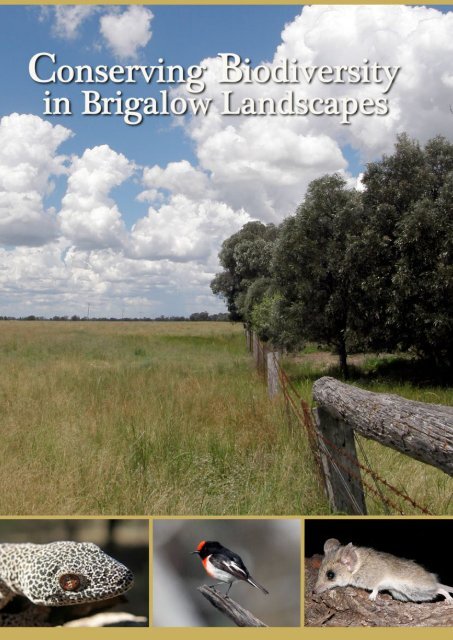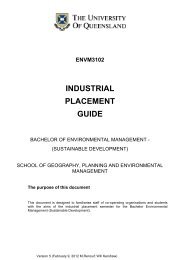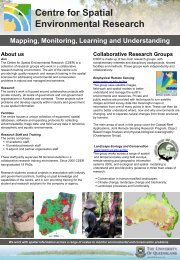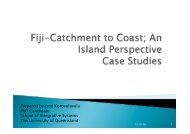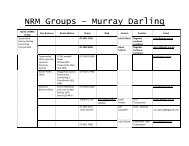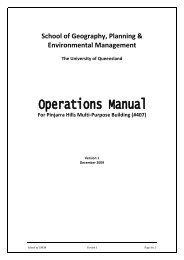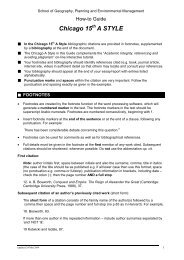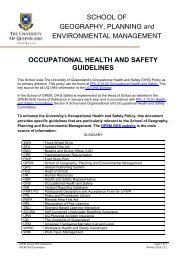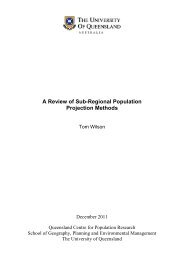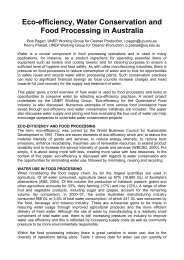Conserving Biodiversity in Brigalow Regrowth - School of ...
Conserving Biodiversity in Brigalow Regrowth - School of ...
Conserving Biodiversity in Brigalow Regrowth - School of ...
You also want an ePaper? Increase the reach of your titles
YUMPU automatically turns print PDFs into web optimized ePapers that Google loves.
PARTNERS<br />
CONTRIBUTORS<br />
Associate Pr<strong>of</strong>essor Clive McAlp<strong>in</strong>e<br />
c.mcalp<strong>in</strong>e@uq.edu.au<br />
Clive is a landscape ecologist at The University <strong>of</strong> Queensland. He<br />
studies the effect <strong>of</strong> landscape change and climate change on native flora<br />
and fauna, and the feedbacks <strong>of</strong> landscape change on climate.<br />
Dr Mart<strong>in</strong>e Maron<br />
m.maron@uq.edu.au<br />
Mart<strong>in</strong>e is a landscape ecologist at The University <strong>of</strong> Queensland with<br />
a particular <strong>in</strong>terest <strong>in</strong> biodiversity management <strong>in</strong> human-dom<strong>in</strong>ated<br />
landscapes, bird community dynamics and conservation.<br />
Dr Ge<strong>of</strong>frey C. Smith<br />
Ge<strong>of</strong>f.Smith@derm.qld.gov.au<br />
Ge<strong>of</strong>frey is a Pr<strong>in</strong>cipal Zoologist with the Queensland Department <strong>of</strong><br />
Environment and Resource Management. His research <strong>in</strong>terests <strong>in</strong>clude<br />
the fauna and ecosystems <strong>of</strong> brigalow landscapes and fire <strong>in</strong> this system.<br />
Dr Michiala Bowen<br />
michiala.bowen@uqconnect.edu.au<br />
Michiala is a landscape ecologist at The University <strong>of</strong> Queensland. She<br />
studies the effects <strong>of</strong> habitat loss and fragmentation on brigalow wildlife<br />
and the values <strong>of</strong> brigalow regrowth for landscape restoration.<br />
Dr Leonie Seabrook<br />
l.seabrook@uq.edu.au<br />
Leonie is a landscape ecologist at The University <strong>of</strong> Queensland. She<br />
studies the patterns and causes <strong>of</strong> habitat loss and fragmentation over<br />
time.<br />
Dr John Dwyer<br />
j.dwyer2@uq.edu.au<br />
John is a plant ecologist at the University <strong>of</strong> Western Australia. His PhD<br />
research was undertaken at The University <strong>of</strong> Queensland and focused on<br />
the restoration and carbon potential <strong>of</strong> brigalow regrowth.<br />
Sarah Butler<br />
sarah.butler@uq.edu.au<br />
Sarah is a PhD student <strong>in</strong> landscape ecology at The University <strong>of</strong><br />
Queensland, research<strong>in</strong>g the <strong>in</strong>teractive effects <strong>of</strong> land use, climate<br />
and biological <strong>in</strong>vasions on the biodiversity <strong>of</strong> fragmented brigalow<br />
ecosystems.<br />
Cameron Graham<br />
c.graham@uq.edu.au<br />
Cameron is a PhD student at The University <strong>of</strong> Queensland. He is<br />
currently <strong>in</strong>vestigat<strong>in</strong>g how feral cats and red foxes are <strong>in</strong>teract<strong>in</strong>g with<br />
agricultural landscape <strong>in</strong> the <strong>Brigalow</strong> Belt South.<br />
WILLIAM GOULDING<br />
w.gould<strong>in</strong>g@uq.edu.au<br />
2<br />
Will is a field ecologist with The University <strong>of</strong> Queensland; he has<br />
extensive experience with fauna surveys <strong>in</strong> the Australasian region. He<br />
conducted many <strong>of</strong> the bird and reptile field surveys that contribute to this<br />
booklet and provided many <strong>of</strong> the photographic images.
CONSERVING BIODIVERSITY IN BRIGALOW LANDSCAPES<br />
CONTENTS<br />
Foreword 4<br />
Introduction 5<br />
<strong>Brigalow</strong> landscapes 6<br />
History: transform<strong>in</strong>g the brigalow 7<br />
<strong>Brigalow</strong> woodland: why is it important? 9<br />
Threats to <strong>Brigalow</strong> 10<br />
Climate, variability and change 11<br />
Scales <strong>of</strong> habitat management 12<br />
How much vegetation? 14<br />
<strong>Regrowth</strong> is important 15<br />
Manag<strong>in</strong>g regrowth: to th<strong>in</strong> or not to th<strong>in</strong>? 16<br />
Roadside treel<strong>in</strong>es: are they too narrow? 17<br />
Key habitat features 18<br />
Problem species 19<br />
Iconic species 20<br />
Types <strong>of</strong> landscapes 23<br />
Fauna species list 24<br />
Quick reference guide 26<br />
Useful contacts and resources 27<br />
Further read<strong>in</strong>g 27<br />
3
Foreword<br />
Times change.<br />
In 1960 when I graduated B. Agr.<br />
Science from the University <strong>of</strong><br />
Queensland the prevail<strong>in</strong>g ethos was<br />
that unproductive lands should be<br />
developed, as a priority. The brigalow<br />
lands were at the top <strong>of</strong> the list.<br />
New methods <strong>of</strong> clear<strong>in</strong>g us<strong>in</strong>g heavy<br />
mach<strong>in</strong>ery and aerial spray<strong>in</strong>g with<br />
potent herbicides gave momentum<br />
to the attack. Back then the sheer<br />
immensity <strong>of</strong> the brigalow lands<br />
made it difficult to conceive <strong>of</strong> a time<br />
when there would be concern for the<br />
remnants <strong>of</strong> these once dist<strong>in</strong>ctive<br />
landscapes. But with<strong>in</strong> a few decades<br />
less than ten per cent <strong>of</strong> the orig<strong>in</strong>al<br />
cover rema<strong>in</strong>ed. Even this pitiful total<br />
conceals the true picture. Very few<br />
large (>1000 ha.) tracts rema<strong>in</strong> and<br />
even fewer are <strong>in</strong> reserves.<br />
What is more these do not provide a<br />
representative sample <strong>of</strong> the orig<strong>in</strong>al<br />
great diversity <strong>of</strong> brigalow landscapes.<br />
The best developed brigalow<br />
vegetation on the most productive<br />
sites was targeted early and <strong>of</strong> this<br />
virtually noth<strong>in</strong>g rema<strong>in</strong>s.<br />
Much <strong>of</strong> what is left, along roads<br />
and <strong>in</strong> small paddock remnants,<br />
is conservation by default; it was<br />
deemed unavailable or unsuitable<br />
for productive use. The loss <strong>of</strong><br />
biodiversity has been <strong>in</strong>calculable but,<br />
as this booklet affirms, not all is lost.<br />
I have had a life long association and<br />
appreciation <strong>of</strong> brigalow landscapes.<br />
Firstly, around my grandparents’<br />
property <strong>in</strong> the Central Highlands<br />
west from Emerald; later <strong>in</strong> the longsettled<br />
scrublands <strong>of</strong> the Lockyer and<br />
Fassifern valleys, eastern Darl<strong>in</strong>g<br />
Downs and the Burnett Valley <strong>in</strong><br />
south-east Queensland. By my late<br />
teens I had traversed most <strong>of</strong> the<br />
<strong>Brigalow</strong> Belt Bioregion.<br />
Then <strong>in</strong> the early 1960s I consider<br />
myself fortunate to have been a<br />
member <strong>of</strong> the CSIRO teams that<br />
conducted land resource surveys<br />
that preceded the massive clear<strong>in</strong>g<br />
<strong>of</strong> the <strong>Brigalow</strong> Lands Development<br />
Scheme <strong>in</strong> the Fitzroy and Belyando<br />
catchments. These surveys focused<br />
on descriptions <strong>of</strong> land forms, soils<br />
and vegetation and subsequent<br />
evaluation <strong>of</strong> the potential for<br />
agricultural, pastoral and forestry<br />
production. Conservation was not<br />
a focus, but attention was drawn<br />
to the need to reserve adequate<br />
representative samples <strong>of</strong> the<br />
landscapes described, as well as<br />
specific examples <strong>of</strong> unique, unusual<br />
and restricted areas <strong>of</strong> vegetation.<br />
The Government <strong>of</strong> the day<br />
steadfastly ignored this advice and<br />
by the time later Governments took<br />
action, it was too little and too late.<br />
Active brigalow regrowth has been<br />
a scourge for the settler, but it does<br />
provide an opportunity as well as<br />
a challenge. It can provide a basis<br />
for renewal <strong>of</strong> wildlife habitat, for<br />
enhanc<strong>in</strong>g connectivity across<br />
landscapes and for develop<strong>in</strong>g a<br />
potentially valuable carbon s<strong>in</strong>k.<br />
Reta<strong>in</strong><strong>in</strong>g strips <strong>of</strong> regrowth to<br />
provide shade and shelter from the<br />
hot north-west w<strong>in</strong>ds <strong>of</strong> summer and<br />
the cold south-westerlies <strong>of</strong> w<strong>in</strong>ter<br />
for both crops and livestock can be a<br />
plus. In fact, complete farm redesign<br />
to take account <strong>of</strong> natural contours<br />
and dra<strong>in</strong>age l<strong>in</strong>es can overcome<br />
the tyranny <strong>of</strong> the theodolite which<br />
has imposed straight l<strong>in</strong>es on nonl<strong>in</strong>ear<br />
landscapes. As the research<br />
reported <strong>in</strong> this booklet shows even<br />
young brigalow regrowth has some<br />
value for wildlife, with the number<br />
<strong>of</strong> species <strong>in</strong>creas<strong>in</strong>g with age.<br />
Reta<strong>in</strong><strong>in</strong>g but th<strong>in</strong>n<strong>in</strong>g <strong>of</strong> regrowth<br />
can have benefits and this has been<br />
addressed <strong>in</strong> this publication.<br />
All those who have tackled<br />
development <strong>of</strong> brigalow landscapes<br />
have my respect, but I have a deep<br />
sadness for the natural world that has<br />
been lost.<br />
What can be done to stem the loss and<br />
return the landscape to a better balance?<br />
Because much <strong>of</strong> the rema<strong>in</strong><strong>in</strong>g brigalow<br />
vegetation is <strong>in</strong> private ownership, on<br />
farms, ensur<strong>in</strong>g a balance between<br />
production and conservation <strong>of</strong> flora<br />
and fauna is very much a matter for the<br />
<strong>in</strong>dividual landholder.<br />
The years <strong>of</strong> focused research that are<br />
summarized <strong>in</strong> this booklet provide<br />
useful guidel<strong>in</strong>es for the plann<strong>in</strong>g and<br />
management <strong>of</strong> remnant brigalow<br />
vegetation. F<strong>in</strong>ancial <strong>in</strong>centives, such<br />
as taxation concessions, may be<br />
necessary for landholders to take up<br />
these recommendations. The irony is<br />
that taxation concessions were used<br />
to stimulate the massive clearance <strong>of</strong><br />
brigalow <strong>in</strong> the first place!<br />
Henry Nix<br />
Henry Nix is an Emeritus Pr<strong>of</strong>essor at<br />
Australian National University with over<br />
30 years experience study<strong>in</strong>g Australian<br />
landscapes.<br />
4
CONSERVING BIODIVERSITY IN BRIGALOW LANDSCAPES<br />
INTRODUCTION<br />
<strong>Brigalow</strong> (Acacia harpophylla) is a dist<strong>in</strong>ctive silver-foliaged<br />
shrub or tree – one <strong>of</strong> the 980 species <strong>of</strong> Acacia <strong>in</strong> Australia.<br />
The brigalow tree is commonly the dom<strong>in</strong>ant species <strong>of</strong> a<br />
range <strong>of</strong> open forests and woodlands, which are collectively<br />
referred to as brigalow woodlands <strong>in</strong> this booklet. <strong>Brigalow</strong><br />
woodlands are found mostly west <strong>of</strong> the Great Divid<strong>in</strong>g<br />
Range, stretch<strong>in</strong>g north almost to Townsville, south to<br />
Narrabri <strong>in</strong> New South Wales, and west to Bourke on the<br />
Darl<strong>in</strong>g River and Blackall <strong>in</strong> central western Queensland.<br />
They occur mostly on deep crack<strong>in</strong>g clay soils with a<br />
microrelief pattern referred to as gilgai or melon holes which<br />
<strong>in</strong>termittently fill with water.<br />
Scientific understand<strong>in</strong>g <strong>of</strong> brigalow landscapes<br />
and ecosystems lags beh<strong>in</strong>d that <strong>of</strong> many woodland<br />
ecosystems <strong>in</strong> southern Australia.<br />
Over the past 8 years, a team <strong>of</strong> University <strong>of</strong> Queensland<br />
researchers have been conduct<strong>in</strong>g field studies <strong>in</strong> the<br />
<strong>Brigalow</strong> Belt South.<br />
This booklet summarises the ma<strong>in</strong> f<strong>in</strong>d<strong>in</strong>gs <strong>of</strong> these studies.<br />
We aim to provide <strong>in</strong>formation relevant to farmers and<br />
other natural resource managers look<strong>in</strong>g to manage native<br />
vegetation for wildlife habitat with<strong>in</strong> brigalow production<br />
landscapes.<br />
Although our focus is predom<strong>in</strong>antly on southern <strong>Brigalow</strong><br />
Belt landscapes, many <strong>of</strong> the pr<strong>in</strong>ciples outl<strong>in</strong>ed <strong>in</strong> this<br />
booklet are also relevant for the northern <strong>Brigalow</strong> Belt.<br />
5
<strong>Brigalow</strong> Landscapes<br />
The <strong>Brigalow</strong> Belt is an important region nationally for its agricultural production and for its rich diversity <strong>of</strong> native<br />
fauna and flora. For most <strong>of</strong> the 20th century, the focus <strong>of</strong> government was the agricultural development <strong>of</strong> the<br />
region.<br />
More recently, as the Australian community has become<br />
more aware <strong>of</strong> environmental problems, this focus has<br />
shifted to f<strong>in</strong>d<strong>in</strong>g a more susta<strong>in</strong>able balance between<br />
conservation and production.<br />
<strong>Brigalow</strong> remnant vegetation is now protected <strong>in</strong><br />
Queensland and New South Wales and listed as nationally<br />
threatened under the Environment Protection and<br />
<strong>Biodiversity</strong> Conservation Act 1999. However, this alone<br />
is unlikely to ensure the long-term viability <strong>of</strong> native bird,<br />
reptile and mammal populations, many <strong>of</strong> which are <strong>in</strong><br />
serious decl<strong>in</strong>e.<br />
To susta<strong>in</strong> our native flora and fauna it is important to th<strong>in</strong>k<br />
<strong>of</strong> whole landscapes, rather than just <strong>in</strong>dividual patches or<br />
even species. Landscapes are best observed from a light<br />
plane or helicopter and are made up <strong>of</strong> the mix <strong>of</strong> remnant<br />
and regrowth woodland patches, paddocks <strong>of</strong> crops and<br />
pastures and farm dams. Many brigalow landscapes have<br />
less than 10% native vegetation rema<strong>in</strong><strong>in</strong>g, with patches<br />
<strong>of</strong>ten occurr<strong>in</strong>g as narrow l<strong>in</strong>ear strips left along fencel<strong>in</strong>es<br />
and roadsides.<br />
Nevertheless, brigalow landscapes have one important<br />
advantage: retention <strong>of</strong> naturally regenerat<strong>in</strong>g or regrowth<br />
vegetation that occurs <strong>in</strong> formerly cleared areas is a lowcost<br />
and highly efficient way to restore habitat.<br />
Although not all regrowth is protected (except under some<br />
provisions <strong>in</strong> Queensland and Commonwealth legislation),<br />
landholders are <strong>in</strong>creas<strong>in</strong>gly <strong>in</strong>terested <strong>in</strong> its potential to<br />
contribute to farm <strong>in</strong>come through: a) its value as a carbon<br />
s<strong>in</strong>k, and b) the delivery <strong>of</strong> ecological services for which<br />
stewardship payments are made.<br />
To successfully manage brigalow landscapes for conservation as well as production, we need<br />
to understand how the region’s fauna are affected by how humans <strong>in</strong>fluence the landscape.<br />
This booklet answers a set <strong>of</strong> the most important questions on how to manage brigalow<br />
vegetation for conserv<strong>in</strong>g and restor<strong>in</strong>g wildlife <strong>in</strong> the region, <strong>in</strong>clud<strong>in</strong>g:<br />
1. How much vegetation is enough?<br />
2. What are the priority areas to restore?<br />
3. How important are l<strong>in</strong>ear patches?<br />
4. How important is connectivity among patches?<br />
5. How important is regrowth <strong>of</strong> different ages and how can we manage it for<br />
biodiversity?<br />
6. What management actions would help to <strong>in</strong>crease the diversity <strong>of</strong> animal species and their<br />
abundance?<br />
6<br />
* See page 26 for a quick reference guide with practical answers to these questions.
CONSERVING BIODIVERSITY IN BRIGALOW LANDSCAPES<br />
History: Transform<strong>in</strong>g the <strong>Brigalow</strong><br />
<strong>Brigalow</strong> is an aborig<strong>in</strong>al name adopted by white settlers who pushed north and <strong>in</strong>land from the Hunter Valley <strong>in</strong> the<br />
1830s and 1840s.<br />
One <strong>of</strong> the first references to brigalow was <strong>in</strong> Ludwig Leichhardt’s journal <strong>of</strong> his expedition from Moreton Bay to Port<br />
Ess<strong>in</strong>gton, published <strong>in</strong> 1847:<br />
“After hav<strong>in</strong>g past the great pla<strong>in</strong>s <strong>of</strong> the Condam<strong>in</strong>e,<br />
between Coxcens[uncerta<strong>in</strong>?] Station, Fimba and Rupells<br />
Stations we entered <strong>in</strong>to a country, which was alternately<br />
covered with f<strong>in</strong>e open forestland, well grassed and fit<br />
for cattle and horses breed<strong>in</strong>g – and with long stretches<br />
<strong>of</strong> almost impassable Bricklow scrub, so called from the<br />
Bricklow (a species <strong>of</strong> acacia) be<strong>in</strong>g one <strong>of</strong> the pr<strong>in</strong>cipal<br />
components.<br />
Open Myalscrub was frequent, particularly along the<br />
Condam<strong>in</strong>e. Though the Bricklow scrubs were frequently <strong>of</strong><br />
great length and breadth, I do not th<strong>in</strong>k that they ever form<br />
un<strong>in</strong>terrupted l<strong>in</strong>es <strong>of</strong> more than 20–30 miles so that they<br />
allways allow to be skirted.<br />
The frequency <strong>of</strong> these scrubs however would render the<br />
establishment <strong>of</strong> stations unadviseable, as they not only<br />
allow a secure retreat to hostile blackfellows, but to wild<br />
cattle.”<br />
– (Report <strong>of</strong> the Expedition <strong>of</strong> L. Leichhardt Esq. From<br />
Moreton Bay to Port Ess<strong>in</strong>gton)<br />
Early settlement<br />
The early European settlers <strong>of</strong> the Darl<strong>in</strong>g Downs faced a<br />
multitude <strong>of</strong> challenges <strong>in</strong> transform<strong>in</strong>g the land. Dur<strong>in</strong>g the<br />
1860s and 70s, as people <strong>in</strong>itially attempted to clear forests<br />
for pasture and agriculture, they cursed the dense brigalow<br />
woodlands that defied the axe, fenc<strong>in</strong>g them <strong>of</strong>f as waste<br />
country.<br />
They quickly realised the ability <strong>of</strong> brigalow to reappear as<br />
dense sucker regrowth, which was even more difficult to<br />
remove.<br />
A series <strong>of</strong> droughts affected much <strong>of</strong> eastern Australia from<br />
the 1880s through to 1902 culm<strong>in</strong>at<strong>in</strong>g <strong>in</strong> the Federation<br />
drought <strong>of</strong> 1901–02, when up to 90% <strong>of</strong> livestock on<br />
some properties died and livestock numbers halved <strong>in</strong> the<br />
southern <strong>Brigalow</strong> Belt.<br />
Dur<strong>in</strong>g these difficult times, many settlers <strong>of</strong> brigalow<br />
country abandoned their land and moved to towns to f<strong>in</strong>d<br />
work.<br />
7
Between the Wars<br />
After WWI, development <strong>of</strong> the southern <strong>Brigalow</strong><br />
Belt progressed slowly, due largely to the resilient<br />
nature <strong>of</strong> the plant and the lack <strong>of</strong> technology to deal<br />
with its defences.<br />
Between 1880 and 1934, the southern <strong>Brigalow</strong> Belt<br />
was <strong>in</strong>vaded by prickly pear (Opuntia species).<br />
The successful control <strong>of</strong> prickly pear <strong>in</strong> the early<br />
1930s meant that development <strong>of</strong> brigalow lands<br />
began aga<strong>in</strong>. At first, development was relatively<br />
slow due to a lack <strong>of</strong> mechanisation.<br />
8<br />
The settlers were a hardy lot and by the outbreak <strong>of</strong><br />
WWII large blocks <strong>of</strong> brigalow <strong>in</strong> southern districts<br />
like Tara had been cleared by axe, burn<strong>in</strong>g and<br />
<strong>in</strong>tensive sheep graz<strong>in</strong>g.<br />
Broad-scale clear<strong>in</strong>g<br />
Follow<strong>in</strong>g WWII, technological change <strong>in</strong>creased the<br />
pace <strong>of</strong> brigalow development.<br />
One famous land clear<strong>in</strong>g contractor, Joh Bjelke-<br />
Peterson – later Premier <strong>of</strong> Queensland – pioneered<br />
a technique for quickly clear<strong>in</strong>g scrub by connect<strong>in</strong>g<br />
a heavy anchor cha<strong>in</strong> between two bulldozers.<br />
Mechanised clear<strong>in</strong>g soon became a common<br />
practice and by 1954 the most determ<strong>in</strong>ed efforts to<br />
clear brigalow woodlands began.<br />
In the eight years between 1953 and 1961, 1 million<br />
ha were cleared at a rate <strong>of</strong> 120,000 ha per year.<br />
In 1962, The <strong>Brigalow</strong> and Other Lands Development<br />
Act was passed. Under the <strong>Brigalow</strong> Development<br />
Scheme, approximately 2 million ha was allocated<br />
<strong>in</strong> the Bauh<strong>in</strong>ia, Taroom and Duar<strong>in</strong>ga districts, with<br />
a further 2.4 million ha <strong>in</strong> the <strong>Brigalow</strong> Belt North.<br />
Properties were to be large enough to stock 1,000<br />
cattle. State and Commonwealth governments<br />
provided loans <strong>of</strong> up to $60,000 for settlers to cover<br />
development costs, plus pay<strong>in</strong>g for the construction<br />
<strong>of</strong> 1,200 km <strong>of</strong> development roads.<br />
By the 1970s, most <strong>of</strong> the brigalow scrub had<br />
disappeared. Vast areas <strong>of</strong> sucker regrowth were<br />
controlled by aerial spray<strong>in</strong>g with 2,4,5-T and 2,4-D,<br />
burn<strong>in</strong>g and mechanical means, <strong>in</strong> preparation for<br />
improved pastures and cropp<strong>in</strong>g.<br />
Sheep numbers decl<strong>in</strong>ed markedly matched by a rise<br />
<strong>in</strong> cattle numbers and the area under crops.<br />
The rise <strong>in</strong> cropp<strong>in</strong>g was l<strong>in</strong>ked to a severe decl<strong>in</strong>e <strong>in</strong><br />
cattle prices <strong>in</strong> the 1970s and to the more effective<br />
control <strong>of</strong> <strong>Brigalow</strong> regrowth us<strong>in</strong>g blade plough<strong>in</strong>g,<br />
whereby the roots were cut <strong>of</strong>f under the soil.<br />
Lynelle, Amy, Jemma & Warren Urquhart on Warrowa<br />
Warrowa<br />
Warren and Lynelle Urquhart, owners <strong>of</strong> Warrowa, 26 km<br />
west <strong>of</strong> Moonie, believe <strong>in</strong> the values <strong>of</strong> biodiversity and try to<br />
manage their cropp<strong>in</strong>g and cattle graz<strong>in</strong>g for both economic<br />
and environmental long term susta<strong>in</strong>ability.<br />
What is now “Warrowa” (3,600 ha) was part <strong>of</strong> “Ulupna”<br />
(29,000 acres), a prickly pear ballot that was drawn <strong>in</strong> 1934 by<br />
Archibald Telford and worked by him and his brother, George.<br />
In 1945 George took up Warrowa as his own and set about<br />
develop<strong>in</strong>g the property <strong>in</strong>tegrat<strong>in</strong>g native brigalow vegetation<br />
retention (both remnant and regrowth) mostly as shade l<strong>in</strong>es<br />
around each paddock, which was cont<strong>in</strong>ued by the Urquharts<br />
when they took over <strong>in</strong> 2000.<br />
“About 20% <strong>of</strong> Warrowa is reta<strong>in</strong>ed as both remnant and<br />
regrowth brigalow mostly <strong>in</strong> shade l<strong>in</strong>es that border each<br />
paddock, creat<strong>in</strong>g corridors that stretch throughout the length<br />
& breadth <strong>of</strong> the property. Another 15% <strong>of</strong> Warrowa is mixed<br />
eucalypt woodland on a ridge <strong>of</strong> red, sandy loam runn<strong>in</strong>g<br />
through the property. We see these wooded areas as valuable<br />
assets for stock shelter<strong>in</strong>g from temperature extremes,<br />
for w<strong>in</strong>d breaks for crops and pastures and reduction <strong>in</strong><br />
evapotranspiration <strong>of</strong> soil moisture, reduc<strong>in</strong>g dra<strong>in</strong>age below<br />
pasture root zones to keep salt levels where they should be, as<br />
well as important habitat for native flora and fauna.<br />
We know that the fauna (e.g., crows, bats, and other <strong>in</strong>sect<br />
eaters) play an important role <strong>in</strong> pest m<strong>in</strong>imisation <strong>in</strong> our crops<br />
and pastures. Often there can be flocks <strong>of</strong> 200 crows beh<strong>in</strong>d<br />
the tractor devour<strong>in</strong>g all the mice and grubs they can!<br />
We realise that the shade l<strong>in</strong>es could theoretically be razed to<br />
<strong>in</strong>crease the area <strong>of</strong> crops or pasture grown now, which would<br />
<strong>in</strong>crease short term cash flow, but we believe that this practice<br />
would be detrimental to the long term health <strong>of</strong> this land and<br />
therefore also to the economic susta<strong>in</strong>ability <strong>of</strong> farm<strong>in</strong>g here.<br />
It’s important to allot real value to the natural environment.<br />
Just because humans aren’t us<strong>in</strong>g it for a direct and immediate<br />
f<strong>in</strong>ancial benefit at present, doesn’t mean it is “wasted”.<br />
We’re plann<strong>in</strong>g for the long term health and susta<strong>in</strong>ability <strong>of</strong><br />
Warrowa, which isn’t just ours or our children’s tenure on the<br />
land, but hopefully for many, many generations. We need to<br />
make sure we can feed people <strong>in</strong>to the future so we try to run<br />
our farm bus<strong>in</strong>ess <strong>in</strong> an economically and environmentally<br />
balanced way.”<br />
Warren & Lynelle Urquhart, January 2011
CONSERVING BIODIVERSITY IN BRIGALOW LANDSCAPES<br />
<strong>Brigalow</strong> Woodland:<br />
Why is it so important?<br />
Popular op<strong>in</strong>ions <strong>of</strong> brigalow woodlands have changed considerably over the last 50–100 years. Dur<strong>in</strong>g the days<br />
<strong>of</strong> heavy prickly pear <strong>in</strong>festation brigalow was viewed as hav<strong>in</strong>g no use for agricultural production. However, these<br />
views soon changed when prickly pear was controlled and the productivity <strong>of</strong> cleared brigalow lands was realised.<br />
Dur<strong>in</strong>g the 1950s, 60s, 70s and <strong>in</strong>to the 1980s, the most valued brigalow lands were those that were kept clean <strong>of</strong><br />
any natural vegetation.<br />
It is only <strong>in</strong> the last two decades, after most <strong>of</strong> the brigalow<br />
woodlands have been permanently lost, that there has been<br />
<strong>in</strong>creas<strong>in</strong>g recognition <strong>of</strong> their ecological value as home to<br />
a rich diversity <strong>of</strong> fauna and flora. In fact, the <strong>Brigalow</strong> Belt<br />
bioregion is recognised as a national biodiversity hotspot.<br />
For example, the bioregion supports more resident bird<br />
species than any other bioregion <strong>in</strong> Australia. This diversity<br />
arises from the east to west overlap <strong>of</strong> species common to<br />
coastal and arid zone environments, and the north to south<br />
overlap <strong>of</strong> tropical and temperate species.<br />
they support and you will be rewarded with the chorus <strong>of</strong><br />
birdsong fill<strong>in</strong>g the air. If there has been recent ra<strong>in</strong> you may<br />
also hear and see frogs tak<strong>in</strong>g advantage <strong>of</strong> the conditions<br />
and may be lucky to see species like the t<strong>in</strong>y crucifix toad<br />
with its bright yellow, red and green colours. Many <strong>of</strong><br />
the reptiles and small mammals are hard to f<strong>in</strong>d <strong>in</strong> these<br />
woodlands, but a night time walk with a torch may reveal<br />
the bright eye-sh<strong>in</strong>e <strong>of</strong> geckos and you may be lucky to<br />
encounter nocturnal snakes <strong>in</strong> search <strong>of</strong> a feed, like the<br />
woma python.<br />
The common birds <strong>of</strong> the brigalow woodlands <strong>in</strong>clude many<br />
species <strong>in</strong> decl<strong>in</strong>e further south, such as yellow thornbills,<br />
grey-crowned babblers and eastern yellow rob<strong>in</strong>s. Large<br />
groups <strong>of</strong> apostlebirds and white-w<strong>in</strong>ged choughs can<br />
make a walk <strong>in</strong> brigalow woodland a noisy affair. Spotted<br />
bowerbirds are seen more rarely. Reptiles are also well<br />
represented <strong>in</strong> the region, with several species that occur<br />
nowhere else, like the golden-tailed gecko and brigalow<br />
scaly-foot. Other threatened reptile species <strong>in</strong>clude the<br />
common death adder and the yakka sk<strong>in</strong>k.<br />
Native mammals <strong>in</strong>clud<strong>in</strong>g koalas, possums and gliders,<br />
kangaroos and wallabies, bandicoots and small carnivores<br />
all occur <strong>in</strong> the <strong>Brigalow</strong> Belt. T<strong>in</strong>y but ferocious carnivorous<br />
marsupials like the common and narrow-nosed planigales<br />
and common dunnarts, despite their names, are now<br />
rarely encountered. Bats are also rarely seen up close,<br />
but brigalow woodlands support many species <strong>of</strong> the t<strong>in</strong>y<br />
nocturnal <strong>in</strong>sectivorous ‘microbats’, <strong>in</strong>clud<strong>in</strong>g the little pied<br />
bat and the yellow-bellied sheathtail bat. Wallabies and<br />
kangaroos are more commonly encountered, <strong>in</strong>clud<strong>in</strong>g red,<br />
eastern grey and western grey kangaroos, wallaroos, and<br />
black-striped, red-necked and whiptail wallabies.<br />
It is hard to imag<strong>in</strong>e what early settlers explor<strong>in</strong>g vast<br />
stands <strong>of</strong> brigalow woodland would have encountered. It<br />
is rare these days to enter a patch <strong>of</strong> brigalow woodland<br />
and not be able to see through the trees to the other side—<br />
nowadays patches are <strong>of</strong>ten narrow and the understorey<br />
has been opened up by graz<strong>in</strong>g stock.<br />
Some idea <strong>of</strong> the pre-European vegetation conditions<br />
can be ga<strong>in</strong>ed from a walk <strong>in</strong> one <strong>of</strong> the few large stands<br />
conta<strong>in</strong>ed <strong>in</strong> national parks like Err<strong>in</strong>gibba or Southwood.<br />
If you walk far enough <strong>in</strong>to the woodland you can quickly<br />
feel disoriented as the woodland looks the same <strong>in</strong> every<br />
direction. It is not hard to sense why the early settlers felt<br />
uneasy <strong>in</strong> these woodlands.<br />
If you take an early morn<strong>in</strong>g walk through a remnant <strong>of</strong><br />
brigalow woodland you will also realise how much life<br />
TOP: Golden-tailed Gecko, BOTTOM (L-R): Stripe-faced Dunnart and<br />
Grey-crowned Babbler. IMAGES: WILL GOULDING<br />
9
threats to brigalow<br />
Although the brigalow ecological community was orig<strong>in</strong>ally extensive <strong>in</strong> Queensland and northern New South<br />
Wales, less than 10% is left.<br />
Most <strong>of</strong> the brigalow is <strong>in</strong> small patches, shade-l<strong>in</strong>es and<br />
roadside strips. Because <strong>of</strong> this, and ongo<strong>in</strong>g threats to<br />
rema<strong>in</strong><strong>in</strong>g brigalow, the ecological community is listed<br />
as nationally threatened under the Commonwealth<br />
Environment Protection and <strong>Biodiversity</strong> Conservation Act<br />
1999.<br />
Luckily, even relatively small patches <strong>of</strong> brigalow can still<br />
be habitat for many species <strong>of</strong> fauna. The remnant patches<br />
support at least 17 threatened species <strong>of</strong> animals <strong>in</strong>clud<strong>in</strong>g<br />
birds, bats, wallabies and reptiles. Some threatened<br />
species even occupy regrowth brigalow, particularly as it<br />
ages.<br />
Nevertheless, there are still significant threats to rema<strong>in</strong><strong>in</strong>g<br />
brigalow woodland.<br />
Weeds and fire<br />
While there are many weeds that threaten the remnant<br />
brigalow ecosystems, some have potentially disastrous<br />
consequences. In particular, grasses that are useful <strong>in</strong><br />
pasture, such as buffel grass (Cenchrus cilaris) and green<br />
panic (Panicum maximum var. trichoglume), can spread<br />
throughout brigalow remnants, chang<strong>in</strong>g habitat structure<br />
for ground-dwell<strong>in</strong>g fauna and <strong>in</strong>creas<strong>in</strong>g the risk <strong>of</strong> fire.<br />
<strong>Brigalow</strong> and most <strong>of</strong> the plant species which grow <strong>in</strong><br />
brigalow woodland are killed by <strong>in</strong>tense fire, so control <strong>of</strong><br />
grassy weeds with<strong>in</strong> and close to brigalow remnants is the<br />
key to their survival. Tree th<strong>in</strong>n<strong>in</strong>g and soil disturbance can<br />
help weeds enter brigalow woodland patches, and livestock<br />
can br<strong>in</strong>g <strong>in</strong> weed seeds. Careful management <strong>of</strong> graz<strong>in</strong>g<br />
and its exclusion from <strong>in</strong>tact stands <strong>of</strong> brigalow where<br />
possible can help reduce the risk <strong>of</strong> weed <strong>in</strong>vasion.<br />
MICHIALA BOWEN<br />
Overgraz<strong>in</strong>g<br />
<strong>Brigalow</strong> shade-l<strong>in</strong>es and clumps <strong>of</strong> trees are valuable<br />
as shelter for livestock. Careful consideration <strong>of</strong> stock<strong>in</strong>g<br />
numbers and livestock camp sites is important to avoid<br />
damage to the woodland understorey. Heavy graz<strong>in</strong>g and<br />
trampl<strong>in</strong>g reduces the value <strong>of</strong> the woodland for wildlife,<br />
and <strong>of</strong>ten encourages undesirable species such as weeds<br />
and feral animals. Rotational graz<strong>in</strong>g regimes and lower<br />
stock<strong>in</strong>g rates both help to ma<strong>in</strong>ta<strong>in</strong> the value <strong>of</strong> brigalow<br />
woodland for livestock and wildlife.<br />
MICHIALA BOWEN<br />
Clear<strong>in</strong>g<br />
Even though less than 10% <strong>of</strong> orig<strong>in</strong>al brigalow ecosystems<br />
rema<strong>in</strong>, pressure to remove more brigalow cont<strong>in</strong>ues.<br />
Feral animals<br />
Foxes and cats are common <strong>in</strong> the <strong>Brigalow</strong> Belt, and<br />
can threaten native species (See page 19). Mediumsized<br />
mammals (between 50–500 g) are at most risk from<br />
these predators, and they are also known to take native<br />
reptiles and birds as prey. Pigs cause damage to brigalow<br />
woodlands and adjacent farmland, destroy<strong>in</strong>g young plants<br />
and disturb<strong>in</strong>g the soil.<br />
Controll<strong>in</strong>g pigs, foxes and cats requires a coord<strong>in</strong>ated<br />
approach, preferably among groups <strong>of</strong> neighbours and<br />
ideally across subregions.<br />
10<br />
CAMERON GRAHAM<br />
Sometimes this is for large <strong>in</strong>frastructure, m<strong>in</strong><strong>in</strong>g and gas<br />
extraction projects, and sometimes it is for smaller-scale<br />
ma<strong>in</strong>tenance <strong>of</strong> roads and fences.<br />
Every bit lost has an impact on wildlife – many animals<br />
cannot simply move elsewhere when their habitat is cleared,<br />
as there is nowhere to go that is not already occupied by<br />
other <strong>in</strong>dividuals.<br />
In the longer-term, the tendency <strong>of</strong> brigalow to regrow<br />
presents an opportunity to compensate for losses <strong>of</strong> habitat<br />
that cannot be avoided. Although it is not clear whether the<br />
habitat values <strong>of</strong> mature, remnant brigalow can be entirely<br />
replaced by regrowth as it ages, careful management <strong>of</strong><br />
regrowth vegetation might result <strong>in</strong> new suitable habitat<br />
be<strong>in</strong>g created, which can help to reduce the impacts <strong>of</strong><br />
clear<strong>in</strong>g (see page 15).
CONSERVING BIODIVERSITY IN BRIGALOW LANDSCAPES<br />
Climate, VARIABILITY & CHANGE<br />
Climate variability, a critical concern for agricultural production <strong>in</strong> the <strong>Brigalow</strong> Belt, also affects brigalow<br />
ecosystems. Drought stresses trees and can cause their death, while extreme wet years such as 2010 allow<br />
widespread regeneration <strong>of</strong> native trees, shrubs and grasses.<br />
The 2001–2007 drought was comparable <strong>in</strong> severity and<br />
duration with the Federation drought (1898–1903), the worst<br />
drought on record.<br />
Over the past decade, the variability <strong>in</strong> ra<strong>in</strong>fall is well with<strong>in</strong><br />
the range expected from natural variability for the region<br />
recorded for the 130 years <strong>of</strong> records. However, the recent<br />
drought was hotter and the future climate <strong>of</strong> the region is<br />
projected to be hotter.<br />
Over the past decade, average annual temperature <strong>in</strong> the<br />
region has <strong>in</strong>creased by 0.5 o C. This trend is expected to<br />
cont<strong>in</strong>ue, with a projected <strong>in</strong>crease <strong>in</strong> temperature <strong>of</strong> 3–5 o C<br />
by 2070.<br />
For example, the number <strong>of</strong> hot days per year above 35 o C<br />
for Miles is likely to triple from 31 days to 93 days by 2070.<br />
Ra<strong>in</strong>fall is also likely to decl<strong>in</strong>e with a result<strong>in</strong>g <strong>in</strong>crease<br />
<strong>in</strong> evaporation by 6–15%. The number <strong>of</strong> frost days will<br />
decrease. These changes are well outside the range <strong>of</strong><br />
historical climate variability.<br />
Changes <strong>in</strong> temperature and ra<strong>in</strong>fall will place added<br />
pressures on farm<strong>in</strong>g communities, agricultural production<br />
and brigalow ecosystems. Heatwaves are known to cause<br />
physical stress for wildlife that may result <strong>in</strong> death; koalas<br />
are one example <strong>of</strong> a species that is known to suffer higher<br />
mortality dur<strong>in</strong>g heatwaves.<br />
In addition to the physical stresses <strong>of</strong> high temperatures,<br />
prolonged droughts result <strong>in</strong> lowered food availability.<br />
Stressed plants may fail to flower and produce fruits and<br />
<strong>in</strong>sect prey items may become scarce. In 2006–2007 the<br />
prolonged drought conditions <strong>in</strong> Victorian woodlands<br />
resulted <strong>in</strong> the failure <strong>of</strong> eucalypt trees to flower and the<br />
number <strong>of</strong> nectar-feed<strong>in</strong>g birds decl<strong>in</strong>ed sharply.<br />
Animals liv<strong>in</strong>g <strong>in</strong> fragmented brigalow landscapes will be<br />
particularly vulnerable to the effects <strong>of</strong> hotter and drier<br />
conditions as the fragments <strong>of</strong> habitat are too few and far<br />
between to allow animals to move further afield to f<strong>in</strong>d<br />
scarce resources.<br />
In addition to these pressures, high temperatures and<br />
ra<strong>in</strong>fall deficits will hamper efforts to restore brigalow<br />
landscapes—slow growth rates and die-back will result <strong>in</strong><br />
much longer time periods before regrowth can develop <strong>in</strong>to<br />
mature habitat.<br />
11
Scales <strong>of</strong> Habitat Management<br />
Manag<strong>in</strong>g brigalow woodland for a diverse range <strong>of</strong> fauna requires th<strong>in</strong>k<strong>in</strong>g about habitat use at multiple scales.<br />
For example, some animals spend most <strong>of</strong> their lives <strong>in</strong> a small area <strong>of</strong> a hectare or less, but others need to move<br />
over distances <strong>of</strong> hundreds <strong>of</strong> kilometres.<br />
A step back:<br />
the whole patch<br />
It is not just what happens <strong>in</strong> the stand<br />
<strong>of</strong> brigalow that is important to the<br />
fauna that live there.<br />
A patch is an area <strong>of</strong> woodland or<br />
forest that has more or less uniform<br />
characteristics and is bounded by a<br />
land-cover type that is very different.<br />
For example, the edge <strong>of</strong> a brigalow<br />
woodland patch might be where it<br />
meets a paddock <strong>of</strong> wheat.<br />
Up close:<br />
the Forest Stand<br />
Just like people, animals need to have<br />
a place they call home, a place that<br />
provides them with shelter from the<br />
elements and from other animals that<br />
might hunt them, a place to sleep and<br />
raise their young.<br />
A home may be as simple as a cavity<br />
under a log, the crevice under some<br />
peel<strong>in</strong>g bark on a brigalow tree, or the<br />
dense foliage <strong>of</strong> a mistletoe plant.<br />
Traditionally used by forest harvesters,<br />
the term ‘stand’ refers to a small<br />
area with<strong>in</strong> a forest patch. The stand<br />
is a useful way to take a close up<br />
look at what is found with<strong>in</strong> a patch<br />
<strong>of</strong> brigalow woodland and how the<br />
animals that live <strong>in</strong> the woodland may<br />
see th<strong>in</strong>gs.<br />
At this f<strong>in</strong>e scale, consider how many<br />
fallen logs are on the ground, how tall<br />
the trees are, how close together the<br />
trees are and how many shrubs you<br />
can see.<br />
From the animal’s perspective, a<br />
complex or messy woodland is <strong>of</strong>ten<br />
WILL GOULDING<br />
a sign <strong>of</strong> good habitat. Fallen timber,<br />
stand<strong>in</strong>g dead trees, shrubs and a<br />
thick leaf litter are all signs <strong>of</strong> good<br />
homes for wildlife.<br />
Manag<strong>in</strong>g brigalow<br />
woodland stands<br />
for fauna:<br />
Good ground cover and a<br />
shrubby understorey can be<br />
achieved by m<strong>in</strong>imis<strong>in</strong>g the<br />
impact from graz<strong>in</strong>g animals –<br />
by exclud<strong>in</strong>g stock for periods<br />
<strong>of</strong> time to allow low plants to<br />
recover from brows<strong>in</strong>g and<br />
trampl<strong>in</strong>g.<br />
Many animal homes can be<br />
provided by leav<strong>in</strong>g dead trees<br />
stand<strong>in</strong>g and allow<strong>in</strong>g dead<br />
timber to rot where it falls on the<br />
ground.<br />
Sometimes def<strong>in</strong><strong>in</strong>g a patch is difficult;<br />
there may be no sharp boundary<br />
where it jo<strong>in</strong>s unmodified pasture. The<br />
size and shape <strong>of</strong> the entire woodland<br />
patch are important, as well as the<br />
distance between one woodland<br />
patch and another. For example, many<br />
animals need to move throughout a<br />
patch <strong>of</strong> woodland and perhaps to<br />
other patches <strong>of</strong> woodland to f<strong>in</strong>d<br />
food.<br />
Honeyeaters, like the striped<br />
honeyeater, will travel widely with<strong>in</strong> a<br />
day to f<strong>in</strong>d flower<strong>in</strong>g or fruit<strong>in</strong>g plants<br />
(such as mistletoes and eucalypt<br />
blossom). Less frequent but longer<br />
distance movements are necessary<br />
too. Seasonal visitors to the brigalow<br />
woodlands <strong>in</strong>clude the threatened<br />
pa<strong>in</strong>ted honeyeater that travels widely<br />
<strong>in</strong> New South Wales, Queensland and<br />
the Northern Territory and returns<br />
to the brigalow woodlands to breed<br />
dur<strong>in</strong>g the summer months.<br />
Other species like the metallic green<br />
Horsfield’s bronze-cuckoo and the<br />
raucous channel-billed cuckoo<br />
travel all the way from Papua New<br />
Gu<strong>in</strong>ea and Indonesia to the brigalow<br />
woodlands to breed dur<strong>in</strong>g summer.<br />
It’s not just migratory species that<br />
need to travel long distances. Many<br />
young animals need to leave their<br />
family home when they become<br />
<strong>in</strong>dependent and they need to move<br />
considerable distances to f<strong>in</strong>d another<br />
suitable location that is unoccupied.<br />
12
CONSERVING BIODIVERSITY IN BRIGALOW LANDSCAPES<br />
These movements can be much more difficult <strong>in</strong> agricultural<br />
areas. Animals differ <strong>in</strong> their ability to travel across open<br />
country to f<strong>in</strong>d other woodland patches and are at greater<br />
risk <strong>of</strong> predation when cross<strong>in</strong>g open country. Some<br />
animals can only move with<strong>in</strong> woodland patches, so if the<br />
woodland patch they live <strong>in</strong> is too small, they will perish or<br />
be unable to breed.<br />
Manag<strong>in</strong>g brigalow woodland<br />
patches for wildlife:<br />
Leav<strong>in</strong>g large patches <strong>of</strong> woodland on your property<br />
will provide habitat for those species that cannot<br />
travel across open country.<br />
Leav<strong>in</strong>g trees and patches, or even clumps <strong>of</strong><br />
regrowth, <strong>in</strong> your paddocks will ma<strong>in</strong>ta<strong>in</strong> connections<br />
between habitat patches by provid<strong>in</strong>g ‘stepp<strong>in</strong>g<br />
stones’ for the more mobile species.<br />
Connect<strong>in</strong>g your shade-l<strong>in</strong>es to one another will help<br />
animals that need to visit multiple brigalow woodland<br />
patches.<br />
Keep<strong>in</strong>g your shade-l<strong>in</strong>es as wide as possible, ideally<br />
> 100 m, will make it easier for animals to avoid the<br />
edges <strong>of</strong> woodland and farmland if they need to.<br />
MICHIALA BOWEN<br />
Tak<strong>in</strong>g <strong>in</strong> the big picture:<br />
the landscape<br />
Animal populations need to ma<strong>in</strong>ta<strong>in</strong> connections with other<br />
populations <strong>in</strong> the landscape to ma<strong>in</strong>ta<strong>in</strong> genetic diversity<br />
and long-term persistence.<br />
In def<strong>in</strong><strong>in</strong>g the term ‘landscape’, we need to th<strong>in</strong>k about<br />
<strong>in</strong>dividual animals to decide what makes a landscape for<br />
them. In general, a landscape is def<strong>in</strong>ed as an area <strong>of</strong> land<br />
that is large compared to the scale <strong>of</strong> movement <strong>of</strong> the<br />
animal and <strong>of</strong>ten <strong>in</strong>cludes both suitable and less-suitable<br />
habitat.<br />
A landscape for a t<strong>in</strong>y burrow<strong>in</strong>g frog can be only a<br />
few hundred metres across, while for a honeyeater, the<br />
landscape might be kilometres across.<br />
In a practical sense, it is best to th<strong>in</strong>k <strong>of</strong> a landscape <strong>in</strong><br />
terms <strong>of</strong> the area <strong>of</strong> land that you manage, i.e., the entire<br />
property or multiple neighbour<strong>in</strong>g properties. At this<br />
landscape scale, it is important to th<strong>in</strong>k about the total<br />
amount <strong>of</strong> woodland compared to areas <strong>of</strong> production <strong>in</strong><br />
your area <strong>of</strong> management, and how well connected it is to<br />
other areas <strong>of</strong> woodland.<br />
This doesn’t necessarily mean a physical l<strong>in</strong>e <strong>of</strong> trees –<br />
many animals can cross small gaps between patches – but<br />
if you are able to encourage woodland regeneration close<br />
to areas <strong>of</strong> exist<strong>in</strong>g woodland, this is better than creat<strong>in</strong>g an<br />
isolated patch.<br />
Most importantly, the more woodland cover you have <strong>in</strong><br />
your landscape, the better it is likely to be for wildlife. Every<br />
little bit counts.<br />
If you carefully th<strong>in</strong>k about how you manage the woodland<br />
stands, patches and entire landscape <strong>of</strong> your property then<br />
you are likely to achieve the best you can for a range <strong>of</strong><br />
animals.<br />
Manag<strong>in</strong>g your<br />
landscape for wildlife:<br />
Leav<strong>in</strong>g as much woodland <strong>in</strong> the landscape as<br />
possible will result <strong>in</strong> more wildlife.<br />
Protect woodland edges by avoid<strong>in</strong>g herbicide and<br />
pesticide spray drift <strong>in</strong>to woodland patches – this will<br />
help to avoid degradation and shr<strong>in</strong>kage <strong>of</strong> woodland<br />
patches.<br />
Good habitat quality at large scales can be achieved<br />
by work<strong>in</strong>g with neighbours to manage habitat on<br />
more than one property.<br />
13
How much vegetation?<br />
The ma<strong>in</strong> reason so many <strong>of</strong> our native animals have become rarer, and even threatened with ext<strong>in</strong>ction, is because<br />
we have removed much <strong>of</strong> their habitat. Less habitat means fewer <strong>in</strong>dividuals, lead<strong>in</strong>g to population decl<strong>in</strong>e.<br />
Smaller populations are at more risk <strong>of</strong> go<strong>in</strong>g ext<strong>in</strong>ct through chance events; <strong>in</strong> many regions, several species have<br />
disappeared altogether. So how much habitat do we need to reta<strong>in</strong> <strong>in</strong> our landscape if we want to keep most <strong>of</strong> our<br />
wildlife?<br />
The answer is complicated, because<br />
different species need different types<br />
and amounts <strong>of</strong> habitat. However,<br />
there are some general patterns that<br />
we can use as rules-<strong>of</strong>-thumb <strong>in</strong> the<br />
absence <strong>of</strong> detailed, species-specific<br />
<strong>in</strong>formation.<br />
For example, research <strong>in</strong> southern<br />
Australian woodlands suggests that<br />
the number <strong>of</strong> bird species <strong>in</strong> the<br />
landscape decl<strong>in</strong>es most rapidly if<br />
vegetation cover drops below 10%.<br />
Yet work <strong>in</strong> the brigalow suggests<br />
that this threshold might be higher. In<br />
brigalow landscapes, more vegetation<br />
means more bird species at least up to<br />
30% vegetation cover.<br />
Our research has shown that there<br />
is no clear target for the amount<br />
<strong>of</strong> woodland necessary to support<br />
diverse reptile communities <strong>in</strong><br />
the brigalow. But we can say that<br />
landscapes with less than 20%<br />
native vegetation support much lower<br />
diversity and abundance <strong>of</strong> reptiles,<br />
particularly species that have limited<br />
ability to move across open country.<br />
Queensland Department <strong>of</strong> Environment and Resource Management<br />
As with birds, the more brigalow<br />
woodland <strong>in</strong> the landscape, the better<br />
the reptile community.<br />
This means that every effort to reta<strong>in</strong><br />
vegetation helps to ma<strong>in</strong>ta<strong>in</strong> the<br />
richness <strong>of</strong> wildlife communities – and<br />
this is especially true <strong>in</strong> landscapes<br />
with less than 30% <strong>of</strong> the orig<strong>in</strong>al<br />
vegetation rema<strong>in</strong><strong>in</strong>g. It also means<br />
that every small <strong>in</strong>crease <strong>in</strong> vegetation<br />
cover, such as through retention <strong>of</strong><br />
regrowth vegetation, will help species<br />
return to the landscape. Actively<br />
encourag<strong>in</strong>g the regeneration <strong>of</strong><br />
brigalow regrowth <strong>in</strong> these landscapes<br />
is one <strong>of</strong> the best th<strong>in</strong>gs that can<br />
be done for wildlife, with the aim <strong>of</strong><br />
return<strong>in</strong>g overall woodland cover to at<br />
least 30% wherever possible.<br />
All native vegetation contributes to<br />
wildlife habitat – and <strong>in</strong> landscapes<br />
with less rema<strong>in</strong><strong>in</strong>g habitat, every bit<br />
is crucial<br />
MICHIALA BOWEN<br />
14
CONSERVING BIODIVERSITY IN BRIGALOW LANDSCAPES<br />
<strong>Regrowth</strong> is important<br />
<strong>Regrowth</strong> represents a conservation barga<strong>in</strong> because regrowth can grow <strong>in</strong>to mature woodlands without the large<br />
<strong>in</strong>vestment <strong>of</strong> time and resources associated with tree plant<strong>in</strong>g schemes. <strong>Brigalow</strong> has a remarkable capacity to<br />
regrow from root stock <strong>in</strong> the soil, sometimes even after a decade <strong>of</strong> cultivation.<br />
Long regarded as a nuisance by<br />
landholders, brigalow regrowth<br />
currently occupies large areas <strong>in</strong><br />
the <strong>Brigalow</strong> Belt. In comparison<br />
to tree plant<strong>in</strong>g, brigalow regrowth<br />
<strong>of</strong>fers a cost-effective and less<br />
labour-<strong>in</strong>tensive means for<br />
conduct<strong>in</strong>g broad-scale habitat<br />
restoration. This does not mean<br />
that restoration <strong>of</strong> habitat is without<br />
costs for the landholder – the<br />
choice to allow brigalow regrowth<br />
to regenerate could result <strong>in</strong> lost<br />
production. An <strong>in</strong>creas<strong>in</strong>g number<br />
<strong>of</strong> government-funded schemes<br />
provide compensation funds to<br />
landholders who restore former<br />
production lands.<br />
The structure and floristic<br />
composition <strong>of</strong> brigalow regrowth<br />
vegetation is <strong>of</strong>ten very different<br />
from the orig<strong>in</strong>al remnant<br />
woodlands.<br />
Above: The number <strong>of</strong> woodland dependent bird species occupy<strong>in</strong>g regrowth stands<br />
<strong>in</strong>creases with woodland age. After 30 years, regrowth can support as many bird<br />
species as remnant woodlands.<br />
After clear<strong>in</strong>g, young brigalow<br />
regrowth (≤15 years) is low,<br />
with no trees and few shrubs (apart from the brigalow<br />
itself). Intermediate age regrowth (16 – 30 years) exhibits<br />
characteristics overlapp<strong>in</strong>g both young and old regrowth,<br />
but is <strong>of</strong>ten more similar to old regrowth. Old regrowth (><br />
30 years) is taller, has fewer stems and a more ‘tree-like’<br />
shape than the younger shrubby regrowth. Fallen timber,<br />
hollows and a complex ground and shrub layer are still<br />
miss<strong>in</strong>g from old regrowth and may take more than 100<br />
years to develop. These differences <strong>in</strong> the characteristics <strong>of</strong><br />
regrowth woodland compared with remnant brigalow mean<br />
that regrowth does not provide identical habitat as the<br />
orig<strong>in</strong>al woodland.<br />
Over time, brigalow regrowth can develop <strong>in</strong>to important<br />
habitat. Few woodland birds are able to use brigalow<br />
regrowth <strong>in</strong> the first couple <strong>of</strong> decades <strong>of</strong> growth, but after<br />
30 years the regrowth can support the same number <strong>of</strong><br />
species that are found <strong>in</strong> mature woodlands.<br />
This does not mean that only old regrowth is valuable for<br />
fauna. Long before it can provide habitat for a diverse<br />
range <strong>of</strong> species, it can provide other benefits such as<br />
provid<strong>in</strong>g movement pathways for species that cannot<br />
cross paddocks and crops. The dense shrubby structure <strong>of</strong><br />
young regrowth is important breed<strong>in</strong>g habitat and shelter<br />
for animals hid<strong>in</strong>g from <strong>in</strong>troduced predators like cats and<br />
foxes. T<strong>in</strong>y birds like the superb and variegated fairy-wrens<br />
love to hide their nests <strong>in</strong> the young brigalow shrubs.<br />
Remnant<br />
CleareD<br />
Young regrowth<br />
(< 15 yrs)<br />
<strong>in</strong>termediate<br />
regrowth (15- 30 yrs)<br />
OLD regrowth<br />
(> 30 yrs)<br />
15
Manag<strong>in</strong>g dense <strong>Brigalow</strong> regrowth:<br />
To th<strong>in</strong> or not to th<strong>in</strong>?<br />
<strong>Brigalow</strong> regrowth is <strong>of</strong>ten very dense (sometimes > 15,000 stems per hectare) because <strong>of</strong> the plentiful root suckers<br />
produced follow<strong>in</strong>g clear<strong>in</strong>g. Very high densities are particularly common after multiple pull<strong>in</strong>g attempts on deep<br />
clay soils with gilgais.<br />
Stems compete <strong>in</strong>tensely with one<br />
another and grow slowly, so slowly<br />
that dense stands are <strong>of</strong>ten described<br />
as “stunted” or “locked up”. Given<br />
enough time, dense brigalow regrowth<br />
will almost certa<strong>in</strong>ly grow <strong>in</strong>to<br />
woodlands ak<strong>in</strong> to virg<strong>in</strong> stands, but is<br />
it possible to speed up the process by<br />
th<strong>in</strong>n<strong>in</strong>g manually? The answer is yes.<br />
An experimental th<strong>in</strong>n<strong>in</strong>g trial <strong>in</strong> dense<br />
27 year old regrowth near Millmerran<br />
showed that th<strong>in</strong>n<strong>in</strong>g to 4000 – 6000<br />
stems per hectare produces the best<br />
results for woodland recovery and<br />
wildlife habitat. More severe th<strong>in</strong>n<strong>in</strong>g<br />
will open up the canopy and allow<br />
grasses to establish. While this might<br />
seem a positive result for graz<strong>in</strong>g<br />
purposes, it is not so good for wildlife.<br />
High grass cover, particularly buffel<br />
grass, <strong>in</strong>creases the risk <strong>of</strong> fire (see<br />
pgs 10 & 19), which will slow down the<br />
restoration process by kill<strong>in</strong>g trees or<br />
promot<strong>in</strong>g even thicker regrowth.<br />
If the goal is to manage brigalow<br />
regrowth for wildlife habitat, then<br />
canopy cover should be ma<strong>in</strong>ta<strong>in</strong>ed at<br />
more than 50% (i.e. on average more<br />
than half <strong>of</strong> the ground is shaded by<br />
tree canopy) <strong>in</strong> southern Queensland<br />
and northern New South Wales. In<br />
central and northern brigalow regions<br />
we recommend ma<strong>in</strong>ta<strong>in</strong><strong>in</strong>g tree cover<br />
at 70% because buffel grass grows<br />
more vigorously <strong>in</strong> these regions.<br />
In younger regrowth (e.g. 10–15 years<br />
old) it will be necessary to reta<strong>in</strong> more<br />
stems <strong>in</strong> order to ma<strong>in</strong>ta<strong>in</strong> adequate<br />
tree cover. In these cases it may be<br />
best to th<strong>in</strong> <strong>in</strong> stages, for example th<strong>in</strong><br />
down to 10,000 stems per ha <strong>in</strong>itially,<br />
then a few years later th<strong>in</strong> down to<br />
6,000 stems per ha.<br />
If provid<strong>in</strong>g habitat for native fauna<br />
is not the primary goal <strong>of</strong> manag<strong>in</strong>g<br />
regrowth, then the manager might<br />
want to encourage the growth <strong>of</strong><br />
<strong>in</strong>troduced pasture grasses and<br />
manage fire risk by graz<strong>in</strong>g. It is<br />
16<br />
important to know that sites that are<br />
managed <strong>in</strong> this way will not support<br />
the same richness <strong>of</strong> fauna that they<br />
would if managed <strong>in</strong> the way we<br />
describe, as wildlife habitat. However,<br />
from a wildlife perspective, some trees<br />
are better than no trees at all, and so<br />
the more common fauna will even use<br />
regrowth areas which are managed for<br />
graz<strong>in</strong>g and stock shelter.<br />
Th<strong>in</strong>n<strong>in</strong>g methods<br />
Obviously r<strong>in</strong>gbark<strong>in</strong>g takes a lot <strong>of</strong><br />
time and effort, and there may be more<br />
efficient methods available. Regardless<br />
<strong>of</strong> the method used, secondary<br />
sucker<strong>in</strong>g will occur less if th<strong>in</strong>n<strong>in</strong>g is<br />
done after good ra<strong>in</strong>. When th<strong>in</strong>n<strong>in</strong>g, it<br />
is important to reta<strong>in</strong> a range <strong>of</strong> stem<br />
sizes <strong>in</strong> a “natural” arrangement.<br />
For example, a completely random<br />
selection <strong>of</strong> stems yields very natural<br />
arrangements.<br />
Th<strong>in</strong>n<strong>in</strong>g for carbon<br />
Trees sequester carbon as they grow,<br />
but some species sequester more<br />
carbon than others. <strong>Brigalow</strong> is a<br />
high biomass species, mean<strong>in</strong>g that<br />
it stores a lot <strong>of</strong> carbon compared to<br />
other species from a similar climate.<br />
<strong>Brigalow</strong> regrowth therefore has<br />
considerable potential to be used<br />
as carbon s<strong>in</strong>ks. Although th<strong>in</strong>n<strong>in</strong>g<br />
releases some carbon (through the<br />
decay <strong>of</strong> treated stems), th<strong>in</strong>ned<br />
stands will recoup this carbon quickly<br />
and reach their carbon capacity sooner<br />
than unth<strong>in</strong>ned stands. Although<br />
slower, unth<strong>in</strong>ned stands are still likely<br />
to sequester carbon reasonably<br />
quickly.
CONSERVING BIODIVERSITY IN BRIGALOW LANDSCAPES<br />
roadside vegetation and tree-l<strong>in</strong>es:<br />
are they too narrow?<br />
Narrow l<strong>in</strong>ear strips <strong>of</strong> brigalow remnant woodland are a common feature <strong>in</strong> brigalow landscapes. Long narrow bands<br />
<strong>of</strong> woodland can extend for kilometres along the edges <strong>of</strong> roads, and shade-l<strong>in</strong>es mark the boundaries between<br />
paddocks, provid<strong>in</strong>g shade for stock and protect<strong>in</strong>g crops from w<strong>in</strong>d damage and heat stress.<br />
These narrow strips <strong>of</strong> vegetation are <strong>of</strong>ten thought to be<br />
unimportant for wildlife and <strong>of</strong>ten do not appear on maps <strong>of</strong><br />
protected remnant woodland because they are too narrow.<br />
However, our research has shown that these patches <strong>of</strong><br />
brigalow are <strong>of</strong> great importance to wildlife, support<strong>in</strong>g a<br />
wide variety <strong>of</strong> birds and reptiles.<br />
Many have a high abundance <strong>of</strong> mistletoe plants that<br />
provide important fruit and nectar food sources for<br />
woodland birds, like the rare pa<strong>in</strong>ted honeyeater. These<br />
woodlands also provide corridors for animals to move<br />
among patches <strong>of</strong> woodland.<br />
While wider patches generally provide better habitat<br />
for wildlife, even the very narrowest <strong>of</strong> patches are still<br />
important habitat. Very narrow (< 50 m wide) strips are<br />
particularly vulnerable to further degradation from spraydrift<br />
from adjacent cropp<strong>in</strong>g areas and over brows<strong>in</strong>g and<br />
trampl<strong>in</strong>g by cattle and sheep, as well as w<strong>in</strong>d and storm<br />
damage.<br />
The more heavily grazed <strong>of</strong> these narrow strips have few<br />
young trees regenerat<strong>in</strong>g <strong>in</strong> the understorey to replace<br />
mature trees as they die. The future <strong>of</strong> these woodlands is<br />
uncerta<strong>in</strong>, but there are ways to protect them from further<br />
damage.<br />
Exclud<strong>in</strong>g stock, or reduc<strong>in</strong>g the frequency <strong>of</strong> stock access,<br />
will help to ensure that younger trees can grow to maturity.<br />
Careful use <strong>of</strong> herbicides and reta<strong>in</strong><strong>in</strong>g regrowth woodland<br />
on the edges <strong>of</strong> these patches are all ways to buffer these<br />
important habitat features aga<strong>in</strong>st further damage.<br />
MICHIALA BOWEN<br />
17
Key habitat features<br />
What are the most important features for fauna <strong>in</strong> a brigalow woodland stand?<br />
18<br />
High-quality <strong>Brigalow</strong> habitat<br />
complex habitat<br />
structure<br />
For most fauna, a tree canopy is<br />
not enough. In a patch <strong>of</strong> brigalow<br />
woodland, more complex habitat<br />
structure means more species will<br />
f<strong>in</strong>d a home. For example, small birds<br />
such as f<strong>in</strong>ches and fairy-wrens need<br />
dense vegetation, preferably sp<strong>in</strong>y<br />
shrubs, for protection from predators.<br />
Dense understorey also helps to keep<br />
aggressive noisy m<strong>in</strong>ers out.<br />
Reduc<strong>in</strong>g graz<strong>in</strong>g pressure with<strong>in</strong><br />
areas <strong>of</strong> brigalow woodland can<br />
preserve the important shrub layer and<br />
allow it to regenerate. Even areas <strong>of</strong><br />
young regrowth brigalow can act as<br />
shrubby habitat for small birds.<br />
WILL GOULDING<br />
MICHIALA BOWEN<br />
a messy ground layer<br />
A messy ground layer is a good ground<br />
layer. Terrestrial reptiles and small<br />
mammals need fallen timber and leaf<br />
litter for shelter, and this environment<br />
also favours the <strong>in</strong>vertebrates on which<br />
they feed. Melon holes hold water and<br />
create important microhabitats for<br />
frogs and reptiles which prefer damp<br />
areas.<br />
MICHIALA BOWEN<br />
Mistletoes<br />
Mistletoes are an <strong>of</strong>ten misunderstood<br />
component <strong>of</strong> Australian woodlands.<br />
There are many native species <strong>of</strong> these<br />
semi-parasitic plants <strong>in</strong> Australia and<br />
they provide important food (fruit and<br />
nectar), shelter and nest<strong>in</strong>g habitat for<br />
many types <strong>of</strong> animals. Their leaf litter<br />
also benefits ecosystems by return<strong>in</strong>g<br />
nutrients to the soil and enrich<strong>in</strong>g the<br />
ground layer.<br />
Grey mistletoes (Amyema quandang)<br />
are particularly abundant <strong>in</strong> narrow<br />
l<strong>in</strong>ear strips <strong>of</strong> remnant brigalow.<br />
Although many people worry that<br />
heavy mistletoe <strong>in</strong>festation will cause<br />
tree death, the science is less clear. We<br />
do know that their benefits generally<br />
out-weigh any negative effects. They<br />
are unlikely to harm healthy host<br />
trees and they are very important<br />
for ma<strong>in</strong>ta<strong>in</strong><strong>in</strong>g the abundance and<br />
diversity <strong>of</strong> woodland birds that live <strong>in</strong>,<br />
or travel along, these remnant strips.<br />
Hollows and logs<br />
Hollows, cracks and crevices <strong>in</strong> trees<br />
and fallen logs are homes and havens<br />
for animals and plants <strong>in</strong> the brigalow.<br />
They provide places for animals to<br />
hide, breed, feed and bask. We <strong>of</strong>ten<br />
see lizards soak<strong>in</strong>g up the sun’s rays<br />
on a log, but many animals prefer to<br />
stay out <strong>of</strong> harm’s way <strong>in</strong> hollows and<br />
crevices: sleep<strong>in</strong>g, lay<strong>in</strong>g eggs, giv<strong>in</strong>g<br />
birth or car<strong>in</strong>g for young. Cracks and<br />
crevices <strong>in</strong> old and dead trees harbour<br />
native species that will be rendered<br />
homeless if needlessly removed.<br />
Logs on the ground help trap moisture<br />
and reduce erosion as well as act<strong>in</strong>g<br />
as a refuge for plants and animals.<br />
Bryophytes (collective term for<br />
mosses, hornworts and liverworts) are<br />
<strong>of</strong>ten conspicuous on logs; the highest<br />
bryophyte abundance and diversity<br />
occur on old logs.<br />
Numerous species <strong>of</strong> <strong>in</strong>vertebrate eat<br />
bryophytes, lay their eggs on them or<br />
shelter <strong>in</strong> them and this gives rise to a<br />
cha<strong>in</strong> <strong>of</strong> higher order organisms that<br />
utilise this abundance <strong>of</strong> <strong>in</strong>vertebrates.<br />
For example, many ants use older,<br />
decay<strong>in</strong>g logs and this attracts their<br />
predators such as native legless and<br />
burrow<strong>in</strong>g lizards.
CONSERVING BIODIVERSITY IN BRIGALOW LANDSCAPES<br />
Problem species<br />
ALEX McTAVISH<br />
Noisy m<strong>in</strong>er<br />
The noisy m<strong>in</strong>er (or mickey bird) is a native, but problematic<br />
species. Despite the name, it is not related to the<br />
<strong>in</strong>troduced common (or Indian) myna, but to the Australian<br />
honeyeaters. Unlike most <strong>of</strong> our birds, it has benefited from<br />
the changes that humans have wrought <strong>in</strong> the landscape,<br />
and is more common now than prior to European<br />
settlement.<br />
Unfortunately, it is very aggressive towards other birds.<br />
Liv<strong>in</strong>g <strong>in</strong> large groups, noisy m<strong>in</strong>ers will chase and ‘mob’<br />
<strong>in</strong>truders to their territory. In almost all cases, smaller birds<br />
are chased away. Larger birds are attacked too, but are<br />
<strong>of</strong>ten a bit more resilient.<br />
This means that a patch <strong>of</strong> woodland which is home to a<br />
colony <strong>of</strong> noisy m<strong>in</strong>ers is generally only habitat for large,<br />
common species like apostlebirds, magpies, butcherbirds<br />
and large parrots, while all the small woodland birds – many<br />
<strong>of</strong> which are decl<strong>in</strong><strong>in</strong>g – are absent. In fact, noisy m<strong>in</strong>ers<br />
pose one <strong>of</strong> the greatest challenges for conservation <strong>of</strong> our<br />
woodland birds <strong>in</strong> eastern Australia.<br />
To control noisy m<strong>in</strong>ers, we need to look at what it is that<br />
makes a landscape suitable for them <strong>in</strong> the first place.<br />
Noisy m<strong>in</strong>ers prefer woodlands that have an open tree<br />
structure, with little understorey, and which is grazed. If<br />
we can <strong>in</strong>crease the density <strong>of</strong> trees <strong>in</strong> sparse brigalow<br />
vegetation, the number <strong>of</strong> noisy m<strong>in</strong>ers will be reduced and<br />
this means that small birds will return.<br />
Some <strong>of</strong> the key th<strong>in</strong>gs that can be done to help woodland<br />
birds to avoid aggression from noisy m<strong>in</strong>ers <strong>in</strong>clude:<br />
1) encourage and protect shrubby understorey;<br />
2) manage graz<strong>in</strong>g pressure so that it does not degrade<br />
native vegetation; and<br />
3) value dense stands <strong>of</strong> trees and regrowth, which noisy<br />
m<strong>in</strong>ers do not like.<br />
Around the house, plant<strong>in</strong>g dense shrubs <strong>in</strong> the garden<br />
and limit<strong>in</strong>g the amount <strong>of</strong> nectar-produc<strong>in</strong>g shrubs and<br />
trees can help too. Most <strong>of</strong> our honeyeaters (like the sp<strong>in</strong>ycheeked,<br />
striped and s<strong>in</strong>g<strong>in</strong>g honeyeaters <strong>of</strong> the brigalow)<br />
actually mostly eat <strong>in</strong>sects, so they won’t m<strong>in</strong>d!<br />
CAMERON GRAHAM<br />
Foxes and cats<br />
Introduced predators like the European red fox and the<br />
feral cat are not just a nuisance for farmers but also have<br />
a devastat<strong>in</strong>g effect on wildlife. A wide range <strong>of</strong> native<br />
animals are vulnerable to predation by these exotic species,<br />
<strong>in</strong>clud<strong>in</strong>g small mammals like dunnarts and planigales, birds<br />
that nest and feed near the ground, and many different<br />
reptile species.<br />
Landscapes dom<strong>in</strong>ated by cropp<strong>in</strong>g and with many roads<br />
and small fragments <strong>of</strong> brigalow provide optimal conditions<br />
for cats and foxes to hunt and breed. We recorded the<br />
greatest frequency <strong>of</strong> feral predator activity near l<strong>in</strong>ear<br />
woodlands and roadsides, and the least <strong>in</strong> the <strong>in</strong>terior <strong>of</strong><br />
large brigalow patches. Therefore, focus<strong>in</strong>g pest control<br />
along roads and l<strong>in</strong>ear strips may <strong>in</strong>crease success <strong>in</strong><br />
controll<strong>in</strong>g these pests, and us<strong>in</strong>g regrowth to buffer and<br />
enlarge brigalow patches could help reduce their impact on<br />
wildlife.<br />
ANDREW SMITH<br />
Buffel and green panic<br />
Non-native pasture grasses like buffel and green panic<br />
may be good for graz<strong>in</strong>g animals, but when they grow<br />
<strong>in</strong> brigalow woodland they out-compete the native<br />
understorey plants, which are an important part <strong>of</strong> wildlife<br />
habitat. They also <strong>in</strong>crease the risk <strong>of</strong> bush-fires that kill<br />
the brigalow trees. Our research <strong>in</strong> the region between<br />
Goondiw<strong>in</strong>di and Emerald has shown that these grasses<br />
will thrive <strong>in</strong> l<strong>in</strong>ear strips <strong>of</strong> brigalow that have a more open<br />
tree canopy as a result <strong>of</strong> droughts and other disturbances<br />
caus<strong>in</strong>g tree deaths. These grasses are particularly<br />
abundant <strong>in</strong> the northern <strong>Brigalow</strong> Belt as they prefer areas<br />
with a high mean maximum temperature and high mean<br />
annual ra<strong>in</strong>fall.<br />
With predictions for a hotter regional climate across the<br />
<strong>Brigalow</strong> Belt, these non-native grasses may replace the<br />
native understorey plants that are important for wildlife<br />
habitat.<br />
19
Iconic species and their habitat<br />
WILL GOULDING<br />
Pa<strong>in</strong>ted honeyeater<br />
The pa<strong>in</strong>ted honeyeater is threatened nationally, but<br />
brigalow woodlands are one <strong>of</strong> its last strongholds. This<br />
small, strik<strong>in</strong>gly marked bird is a mistletoe specialist, so the<br />
mistletoe-rich brigalow landscapes are the key to its longterm<br />
survival.<br />
Pa<strong>in</strong>ted honeyeaters are very mobile, nomadically follow<strong>in</strong>g<br />
mistletoe resources. They follow roadside vegetation<br />
especially <strong>in</strong> the brigalow where l<strong>in</strong>ear strips have very high<br />
densities <strong>of</strong> mistletoe, and may even breed <strong>in</strong> these l<strong>in</strong>ear<br />
strips. Some <strong>of</strong> the most important requirements for pa<strong>in</strong>ted<br />
honeyeaters are mistletoe—<strong>of</strong> any species, but preferably<br />
at high densities—and a lack <strong>of</strong> noisy m<strong>in</strong>ers (as pa<strong>in</strong>ted<br />
honeyeaters are susceptible to be<strong>in</strong>g chased <strong>of</strong>f by this<br />
aggressive honeyeater).<br />
ROBERT SUTHERST<br />
Grey-crowned babbler<br />
One <strong>of</strong> the species most familiar to those liv<strong>in</strong>g <strong>in</strong> the<br />
<strong>Brigalow</strong> Belt is the grey-crowned babbler. Yet for most<br />
people liv<strong>in</strong>g <strong>in</strong> the woodland zone to the south, the species<br />
is a rarity.<br />
It is now ext<strong>in</strong>ct <strong>in</strong> South Australia and almost so <strong>in</strong> western<br />
Victoria. It is endangered <strong>in</strong> northern Victoria, where the<br />
revegetation efforts <strong>of</strong> a group <strong>of</strong> dedicated people have<br />
brought it back from the br<strong>in</strong>k, and it is decl<strong>in</strong><strong>in</strong>g <strong>in</strong> New<br />
South Wales. So those <strong>of</strong> uswho still enjoy the garrulous<br />
antics <strong>of</strong> a local babbler group are lucky! Yet it seems<br />
the wave <strong>of</strong> grey-crowned babbler decl<strong>in</strong>e is head<strong>in</strong>g<br />
northward. Now is the time to take preventative action—to<br />
try to avoid the decl<strong>in</strong>es occurr<strong>in</strong>g further south.<br />
Babblers live <strong>in</strong> family groups, and breed cooperatively,<br />
with everyone help<strong>in</strong>g out at the nest. Therefore, they need<br />
to range over a large area to support the group, preferably<br />
without hav<strong>in</strong>g to cross very large open areas. They also<br />
need shrubs or young trees for the large nests they use for<br />
breed<strong>in</strong>g and roost<strong>in</strong>g. Ensur<strong>in</strong>g that connectivity between<br />
woodland patches is not reduced can help, as well as<br />
mak<strong>in</strong>g sure that woodlands are regenerat<strong>in</strong>g to provide<br />
shelter and nest sites.<br />
Eastern yellow rob<strong>in</strong><br />
The sweet, pip<strong>in</strong>g note <strong>of</strong> the eastern yellow rob<strong>in</strong> is heard<br />
only <strong>in</strong> the denser stands <strong>of</strong> brigalow, which it favours. It<br />
prefers woodlands where there is not too much non-native<br />
pasture grass and plenty <strong>of</strong> f<strong>in</strong>e leaf litter, even along<br />
roadsides and <strong>in</strong> relatively small patches. However, the<br />
species seems to be disappear<strong>in</strong>g from smaller woodland<br />
remnants further south, and our recent research <strong>in</strong> the<br />
brigalow found the rob<strong>in</strong>s had higher levels <strong>of</strong> stress where<br />
they lived <strong>in</strong> the most fragmented landscapes. Ideally,<br />
a patch <strong>of</strong> at least 30 hectares <strong>of</strong> brigalow seems to be<br />
needed for eastern yellow rob<strong>in</strong>s to be healthy.<br />
These and other species <strong>of</strong> rob<strong>in</strong> pounce upon <strong>in</strong>vertebrate<br />
prey from their perch on the trunks <strong>of</strong> trees and low<br />
branches, so although they like dense woodland, they avoid<br />
areas with dense grassy ground layers. Leaf litter and fallen<br />
branches create ideal forag<strong>in</strong>g conditions and so leav<strong>in</strong>g<br />
branches where they fall will encourage the rob<strong>in</strong>s and<br />
other ground-forag<strong>in</strong>g species.<br />
20<br />
ROBERT SUTHERST<br />
WARATAHSOFTWARE.COM.AU<br />
White-throated treecreeper<br />
The white-throated treecreeper might be the next bird to<br />
disappear from brigalow woodlands. Today, it only occurs<br />
<strong>in</strong> the very largest patches <strong>of</strong> brigalow—e.g., Southwood<br />
and Err<strong>in</strong>gibba National Parks. It is one <strong>of</strong> only two barkforag<strong>in</strong>g<br />
specialists <strong>in</strong> the brigalow (the other is the varied<br />
sittella). Family groups <strong>of</strong> up to three to five <strong>in</strong>dividuals<br />
forage from tree to tree, start<strong>in</strong>g at the base and work<strong>in</strong>g<br />
their way up, cl<strong>in</strong>g<strong>in</strong>g to the trunks with their strong claws.<br />
The females disperse to jo<strong>in</strong> other groups or start new<br />
groups–but now, there are few places for young female<br />
treecreepers to disperse to.
CONSERVING BIODIVERSITY IN BRIGALOW LANDSCAPES<br />
WILL GOULDING<br />
Planigales<br />
While four species <strong>of</strong> mammal <strong>in</strong> the brigalow have severely<br />
decl<strong>in</strong>ed and about ten have become ext<strong>in</strong>ct, the planigales<br />
manage to persist. However, they are not commonly<br />
encountered.<br />
The two species most likely to occur <strong>in</strong> the brigalow are<br />
the common planigale and the narrow-nosed planigale.<br />
With average weights around 11 grams for males and 7.5<br />
grams for females they are a dim<strong>in</strong>utive marsupial with a flat<br />
body shape (and are thus sometimes called ‘flat weasels’).<br />
They are rarely seen because <strong>of</strong> their small size and quick,<br />
furtive habits. Planigales eat a variety <strong>of</strong> <strong>in</strong>sects that <strong>in</strong>clude<br />
grasshoppers and moths, but will also eat small sk<strong>in</strong>ks.<br />
Common planigales shelter by day under rocks, fallen<br />
timber and bark, while narrow-nosed planigales spend<br />
much <strong>of</strong> their time <strong>in</strong> the cracks <strong>of</strong> crack<strong>in</strong>g clay soils to<br />
avoid the heat.<br />
WILL GOULDING<br />
Death adder<br />
While it may seem difficult to embrace the value and beauty<br />
<strong>of</strong> snakes, they are important to the ecology <strong>of</strong> the brigalow.<br />
Snakes should be left alone; they are protected under State<br />
legislation, and try<strong>in</strong>g to kill them is dangerous. Snakes can<br />
actually be very useful as pest controllers—rats and mice<br />
are common prey items. Be snake aware, look out for them<br />
and appreciate their elegance. Many species have now<br />
become so rare through years <strong>of</strong> persecution and habitat<br />
loss that you are lucky to encounter them. The death adder<br />
is one <strong>of</strong> those species whose numbers have crashed and<br />
may be fac<strong>in</strong>g ext<strong>in</strong>ction, though they are secretive and<br />
difficult to see anyway.<br />
It is difficult to confuse the death adder with any other<br />
snake when seen properly, but they do frequently lie<br />
motionless and concealed with<strong>in</strong> leaf litter. The tail can be<br />
wiggled so that it looks like a worm and is used to attract<br />
prey. The strike is lightn<strong>in</strong>g fast!<br />
LUKE HOGAN<br />
microbats- eastern cave bats<br />
Microbats are common throughout the <strong>Brigalow</strong> Belt.<br />
Microbats are a group <strong>of</strong> small <strong>in</strong>sect eat<strong>in</strong>g bats with<br />
poorly developed eyes. Unlike the megabats (or fly<strong>in</strong>g<br />
foxes) which have well developed sense <strong>of</strong> sight and smell,<br />
microbats use echolocation to navigate around and locate<br />
their prey. In other words they emit sounds <strong>in</strong> order to get<br />
echoes from objects with<strong>in</strong> their environment; no echo<br />
<strong>in</strong>dicates a space, while a returned echo <strong>in</strong>dicates either an<br />
object to be avoided or sought after if it is mov<strong>in</strong>g prey.<br />
Microbats are capable <strong>of</strong> demolish<strong>in</strong>g <strong>in</strong>sect pests <strong>in</strong><br />
considerable volume. Approximately 20 species <strong>of</strong> microbat<br />
have been identified by recent studies <strong>in</strong> the <strong>Brigalow</strong> Belt,<br />
<strong>in</strong>clud<strong>in</strong>g the eastern cave bat (pictured), which as its name<br />
implies roosts ma<strong>in</strong>ly <strong>in</strong> small groups <strong>in</strong> the well-lit areas<br />
<strong>of</strong> caves and overhangs. Other species <strong>of</strong> microbat utilise<br />
tree hollows as their roosts and this is why it is important to<br />
conserve large old trees with hollows, cracks and crevices.<br />
WILL GOULDING<br />
Geckoes<br />
The house gecko, also known as the ‘wall tiger’, is one <strong>of</strong><br />
the most familiar reptiles <strong>of</strong> the brigalow. It has remarkable<br />
ability to cl<strong>in</strong>g to vertical walls and defy gravity by cl<strong>in</strong>g<strong>in</strong>g<br />
to ceil<strong>in</strong>gs. Their toes are made up <strong>of</strong> folds that allow them<br />
to perform their hang<strong>in</strong>g feats.<br />
They are one <strong>of</strong> the most common reptiles <strong>in</strong> human<br />
structures and on trees and provide a great service <strong>in</strong><br />
consum<strong>in</strong>g small irritat<strong>in</strong>g <strong>in</strong>sects. They are completely<br />
harmless.<br />
A gecko with arguably greater beauty is slightly less<br />
harmless, although you are unlikely to encounter it <strong>in</strong>doors!<br />
The threatened golden-tailed gecko (pictured) has an ability<br />
to secrete a sticky fluid from pores along the length <strong>of</strong> its<br />
tail, which if it gets <strong>in</strong>to the eyes is highly irritat<strong>in</strong>g. This<br />
beautiful species mostly spends the day hidden <strong>in</strong> hollow<br />
21
limbs and under loose bark on old trees. At night it hunts for<br />
<strong>in</strong>sects <strong>in</strong> the branches and foliage <strong>of</strong> brigalow trees.<br />
WILL GOULDING<br />
SHINGLEBACK SKINK<br />
Widespread <strong>in</strong> semi-arid regions <strong>of</strong> Australia, the<br />
sh<strong>in</strong>gleback (also known as the stumpy-tail or sleepy lizard)<br />
is a large species <strong>of</strong> sk<strong>in</strong>k that feeds mostly on vegetation.<br />
Sh<strong>in</strong>glebacks have large coarse scales that give them a<br />
heavily armoured appearance.<br />
MICHIALA BOWEN<br />
Crucifix toad<br />
The crucifix toad (or holy cross toad) earns its name by the<br />
yellow and red spots arranged <strong>in</strong> a cross on its yellow to<br />
olive back. This brightly coloured species is abundant on<br />
the black soil floodpla<strong>in</strong>s <strong>of</strong> the <strong>Brigalow</strong> Belt, but typically<br />
only rises from its subterranean haunt follow<strong>in</strong>g heavy ra<strong>in</strong>.<br />
Its call is a series <strong>of</strong> long-owl-like ‘whoo-oos’. If handled, it<br />
can secrete a pasty yellow substance that can be difficult to<br />
remove from hands.<br />
When feel<strong>in</strong>g threatened they will open their mouth wide<br />
to reveal a bright blue tongue <strong>in</strong> an attempt to frighten<br />
<strong>of</strong>f potential predators. Despite their tough attitude and<br />
appearance, their habit <strong>of</strong> sun bak<strong>in</strong>g on roads means that<br />
most people will encounter these impressive sk<strong>in</strong>ks as<br />
road-kill victims.<br />
STEWART MCDONALD<br />
BRIGALOW SCALY-FOOT<br />
While the brigalow scaly-foot may appear superficially to be<br />
a snake, it is <strong>in</strong> fact a flap-footed lizard. That means it has<br />
no forelimbs and the h<strong>in</strong>d limbs are merely small and scalelike<br />
flaps. Unlike snakes it has a broad and fleshy tongue,<br />
ear open<strong>in</strong>gs and a very long tail, which (like other lizards)<br />
they are capable <strong>of</strong> los<strong>in</strong>g if caught by the tail.<br />
MARTIN BENNETT<br />
ROUGH COLLARED FROG<br />
The rough collared frog belongs to a group <strong>of</strong> frogs that are<br />
terrestrial and/or aquatic <strong>in</strong> habit. They have very powerful<br />
h<strong>in</strong>d limbs which assist <strong>in</strong> burrow<strong>in</strong>g. It is a somewhat rarely<br />
encountered species that is restricted to an arid and semiarid<br />
region across the Queensland-NSW border. There is<br />
concern that populations <strong>of</strong> this species are <strong>in</strong> decl<strong>in</strong>e.<br />
Rough collared frogs are found on black-soil and heavy clay<br />
pla<strong>in</strong>s which are typically flooded by heavy ra<strong>in</strong>s. Males<br />
are heard call<strong>in</strong>g after ra<strong>in</strong> usually from flooded areas and<br />
females lay eggs as a loose mass attached to submerged<br />
plants <strong>in</strong> a flooded depression or waterhole, follow<strong>in</strong>g ra<strong>in</strong>.<br />
The brigalow scaly-foot is a smooth glossy reptile that<br />
has a dark and a light band across the neck. The lizard is<br />
active by night and dur<strong>in</strong>g the day it hides <strong>in</strong> thick leaf litter,<br />
woody debris on the forest floor and beneath rocks or logs.<br />
Confus<strong>in</strong>gly to both humans and its predators, it is capable<br />
<strong>of</strong> rear<strong>in</strong>g up like a snake.<br />
22
CONSERVING BIODIVERSITY IN BRIGALOW LANDSCAPES<br />
Types <strong>of</strong> landscapes<br />
We have outl<strong>in</strong>ed many <strong>of</strong> the th<strong>in</strong>gs you can do to help encourage wildlife on your property. But no-one can<br />
do everyth<strong>in</strong>g. What are the most important th<strong>in</strong>gs for wildlife? In part, the answer depends on what sort <strong>of</strong><br />
landscape you are deal<strong>in</strong>g with. Below we list the highest-priority management actions for some examples<br />
<strong>of</strong> different landscape types.<br />
Management Priorities:<br />
High cover landscape<br />
Ma<strong>in</strong>ta<strong>in</strong> habitat condition:<br />
• ma<strong>in</strong>ta<strong>in</strong> low graz<strong>in</strong>g pressure<br />
• control weeds<br />
• control exotic animals<br />
• avoid remov<strong>in</strong>g habitat like fallen timber<br />
moderate cover (connected) landscape<br />
Increase small habitat patch size and l<strong>in</strong>ear patch widths by buffer<strong>in</strong>g exist<strong>in</strong>g<br />
patches with regrowth<br />
Ma<strong>in</strong>ta<strong>in</strong> habitat condition:<br />
• ma<strong>in</strong>ta<strong>in</strong> low graz<strong>in</strong>g pressure<br />
• control weeds<br />
• control exotic animals<br />
• avoid remov<strong>in</strong>g habitat like fallen timber<br />
• allow regrowth for long periods <strong>of</strong> time (decades)<br />
MODERATE COVER (DISCONNECTED) LANDSCAPE<br />
Increase connectivity:<br />
• Reta<strong>in</strong> regrowth to connect nearby patches to one another<br />
Ma<strong>in</strong>ta<strong>in</strong> habitat condition:<br />
• ma<strong>in</strong>ta<strong>in</strong> low graz<strong>in</strong>g pressure<br />
• control weeds<br />
• control exotic animals<br />
• avoid remov<strong>in</strong>g habitat like fallen timber<br />
• allow regrowth for long periods <strong>of</strong> time (decades)<br />
LOW COVER LANDSCAPE<br />
Increase habitat amount:<br />
• <strong>in</strong>crease patch sizes by reta<strong>in</strong><strong>in</strong>g a buffer <strong>of</strong> regrowth vegetation<br />
• create more habitat patches by reta<strong>in</strong><strong>in</strong>g regrowth vegetation<br />
Increase connectivity:<br />
• reta<strong>in</strong> regrowth to connect nearby patches to one another<br />
Ma<strong>in</strong>ta<strong>in</strong> habitat condition:<br />
• ma<strong>in</strong>ta<strong>in</strong> low graz<strong>in</strong>g pressure<br />
• control weeds<br />
• control exotic animals<br />
• avoid remov<strong>in</strong>g habitat like fallen timber<br />
Remnant vegetation<br />
Old regrowth<br />
Young regrowth<br />
Cleared land<br />
Medium aged regrowth<br />
23
LIST OF VERTEBRATE SPECIES<br />
recorded <strong>in</strong> the brigalow belt south dur<strong>in</strong>g university <strong>of</strong> queensland field surveys<br />
How many species do you have on your property? Do you have any we didn’t record?<br />
24
CONSERVING BIODIVERSITY IN BRIGALOW LANDSCAPES<br />
25
QUICK REFERENCE GUIDE<br />
1. How much vegetation is enough?<br />
Patches <strong>of</strong> all sizes contribute to habitat for wildlife, but<br />
larger patches can also support some species that don’t<br />
like small patches. Even small patches and <strong>in</strong>dividual trees<br />
are stepp<strong>in</strong>g stones through the landscape for wildlife.<br />
At the scale <strong>of</strong> an entire landscape (e.g., 1000s ha),<br />
the more vegetation the better, especially <strong>in</strong> heavily<br />
cleared landscapes. In such landscapes, every bit <strong>of</strong><br />
extra vegetation contributes to the number <strong>of</strong> species<br />
the landscape can support. Reta<strong>in</strong><strong>in</strong>g at least 20–30 %<br />
natural vegetation <strong>in</strong> the landscape will result <strong>in</strong> high faunal<br />
biodiversity. Natural vegetation may <strong>in</strong>clude a mixture <strong>of</strong><br />
remnant and regrowth.<br />
2. What are the priority areas to restore?<br />
The answer to this question varies depend<strong>in</strong>g on the<br />
<strong>in</strong>dividual landscape <strong>in</strong> question.<br />
When landscapes have high amounts <strong>of</strong> remnant<br />
woodlands (> 70%), restoration priorities may <strong>in</strong>clude a<br />
focus on: controll<strong>in</strong>g graz<strong>in</strong>g and exotic species disturbance<br />
to ma<strong>in</strong>ta<strong>in</strong> high quality habitat condition. In moderate cover<br />
landscapes (30–70%) ma<strong>in</strong>ta<strong>in</strong><strong>in</strong>g habitat condition and<br />
also buffer<strong>in</strong>g small patches are the best activities. F<strong>in</strong>ally,<br />
<strong>in</strong> landscapes with low native vegetation cover (
CONSERVING BIODIVERSITY IN BRIGALOW LANDSCAPES<br />
Useful contacts & resources<br />
http://www.uq.edu.au/brigalow/<br />
http://condam<strong>in</strong>ealliance.com.au/<br />
http://www.qmdc.org.au/<br />
http://www.brg.cma.nsw.gov.au/<br />
http://www.derm.qld.gov.au/vegetation/<strong>in</strong>dex.html<br />
http://www.environment.gov.au/cgi-b<strong>in</strong>/sprat/public/publicshowcommunity.pl?id=28<br />
http://www.environment.gov.au/biodiversity/threatened/publications/brigalow-regrowth.html<br />
http://www.qhatlas.com.au/content/prickly-pear<br />
http://www.qhatlas.com.au/content/brigalow<br />
http://www.myallparkbotanicgarden.org.au<br />
http://www.brigalowbirds.org<br />
Further read<strong>in</strong>g<br />
Bowen, M.E., McAlp<strong>in</strong>e, C.A., Seabrook, L., House, A.P.N., Smith, G.C., 2009. The age and amount <strong>of</strong> regrowth forest<br />
<strong>in</strong> fragmented brigalow landscapes are both important for woodland dependent birds. Biological Conservation 142,<br />
3051–3059.<br />
Bowen, M.E., McAlp<strong>in</strong>e, C.A., House, A.P.N., Smith, G.C., 2009. Agricultural landscape modification <strong>in</strong>creases the<br />
abundance <strong>of</strong> an important food resource: Mistletoes, birds and brigalow. Biological Conservation 142, 122–133.<br />
Bowen, M.E., McAlp<strong>in</strong>e, C.A., House, A.P.N., Smith, G.C., 2007. <strong>Regrowth</strong> forests on abandoned agricultural land: A<br />
review <strong>of</strong> their habitat values for recover<strong>in</strong>g forest fauna. Biological Conservation 140, 273–296.<br />
<strong>Brigalow</strong> Birds Educational Project 2010, <strong>Brigalow</strong> birds. Lesterlyons Publish<strong>in</strong>g, Brisbane<br />
Chandler, T.S., Buckley, Y.M., Dwyer, J.M., 2007. Restoration potential <strong>of</strong> <strong>Brigalow</strong> regrowth: Insights from a crosssectional<br />
study <strong>in</strong> southern Queensland. Ecological Management & Restoration 8, 218–221.<br />
Collard, S., Le Brocque, A., Zammit, C., 2009. Bird assemblages <strong>in</strong> fragmented agricultural landscapes: the role <strong>of</strong> small<br />
brigalow remnants and adjo<strong>in</strong><strong>in</strong>g land uses. <strong>Biodiversity</strong> and Conservation 18, 1649-1670.<br />
Dwyer, J.M., Fensham, R., Buckley, Y.M., 2010. Restoration th<strong>in</strong>n<strong>in</strong>g accelerates structural development and carbon<br />
sequestration <strong>in</strong> an endangered Australian ecosystem. Journal <strong>of</strong> Applied Ecology 47, 681–691.<br />
Dwyer, J.M., Fensham, R.J., Butler, D.W., Buckley, Y.M., 2009. Carbon for conservation: Assess<strong>in</strong>g the potential for w<strong>in</strong>w<strong>in</strong><br />
<strong>in</strong>vestment <strong>in</strong> an extensive Australian regrowth ecosystem. Agriculture, Ecosystems & Environment 134, 1–7.<br />
Lester, N.C., 2008. Woodland to weeds. 2nd Edition, Copyright Publish<strong>in</strong>g, Brisbane.<br />
Lowik, P.J., 2010. Spatial patterns <strong>of</strong> habitat use by microchiropteran bats <strong>in</strong> a fragmented landscape <strong>of</strong> the southern<br />
<strong>Brigalow</strong> Belt, Queensland, Australia. Honours thesis, <strong>School</strong> <strong>of</strong> Geography, Plann<strong>in</strong>g and Environmental Management,<br />
The University <strong>of</strong> Queensland.<br />
Maron, M., Ma<strong>in</strong>, A., Bowen, M., Howes, A. L., Kath, J., Pillette, C.and McAlp<strong>in</strong>e, C. A. 2011. Relative <strong>in</strong>fluence <strong>of</strong> habitat<br />
modification and <strong>in</strong>terspecific competition on woodland bird assemblages <strong>in</strong> eastern Australia. Emu: Austral Ornithology<br />
111: 40-51<br />
Maron, M, Bowen, M., Fuller, R A, Smith, G C, Eyre, T, Mathieson, M., Watson, J E M & McAlp<strong>in</strong>e, C A. In press. Spurious<br />
relationships and the relationship between species richness and vegetation cover. Global Ecology and Biogeography<br />
Nix, H., 1994. The <strong>Brigalow</strong>, In Australian environmental history. Essays and cases. ed. S. Dovers, pp. 198–233. Oxford<br />
University Press, Melbourne, Victoria.<br />
Seabrook, L., McAlp<strong>in</strong>e, C., Fensham, R., 2008. What <strong>in</strong>fluences farmers to keep trees? A case study from the <strong>Brigalow</strong><br />
Belt, Queensland, Australia. Landscape and Urban Plann<strong>in</strong>g, 84, 266-281.<br />
Seabrook, L., McAlp<strong>in</strong>e, C., Fensham, R., 2007. Spatial and temporal analysis <strong>of</strong> vegetation change <strong>in</strong> agricultural<br />
landscapes: A case study <strong>of</strong> two brigalow (Acacia harpophylla) landscapes <strong>in</strong> Queensland, Australia Agriculture,<br />
Ecosystems & Environment, 120, 211-228.<br />
Seabrook, L., McAlp<strong>in</strong>e, C., Fensham, R., 2006. Cattle, crops and clear<strong>in</strong>g: Regional drivers <strong>of</strong> landscape change <strong>in</strong> the<br />
<strong>Brigalow</strong> Belt, Queensland, Australia, 1840-2004. Landscape and Urban Plann<strong>in</strong>g, 78, 373-385.<br />
27


